Structural geology
1/96
There's no tags or description
Looks like no tags are added yet.
Name | Mastery | Learn | Test | Matching | Spaced |
|---|
No study sessions yet.
97 Terms
Hinge line (zone) (fold axis)
maximum curvature on the fold, described by trend and plunge
Boit Ramburg equation
Layer thickness is highly variable and as layers get thinner, wavelength gets shorter.
Flexural Slip
Slip between beds, visible, contraction and extension at hinge points, veins on outer arc
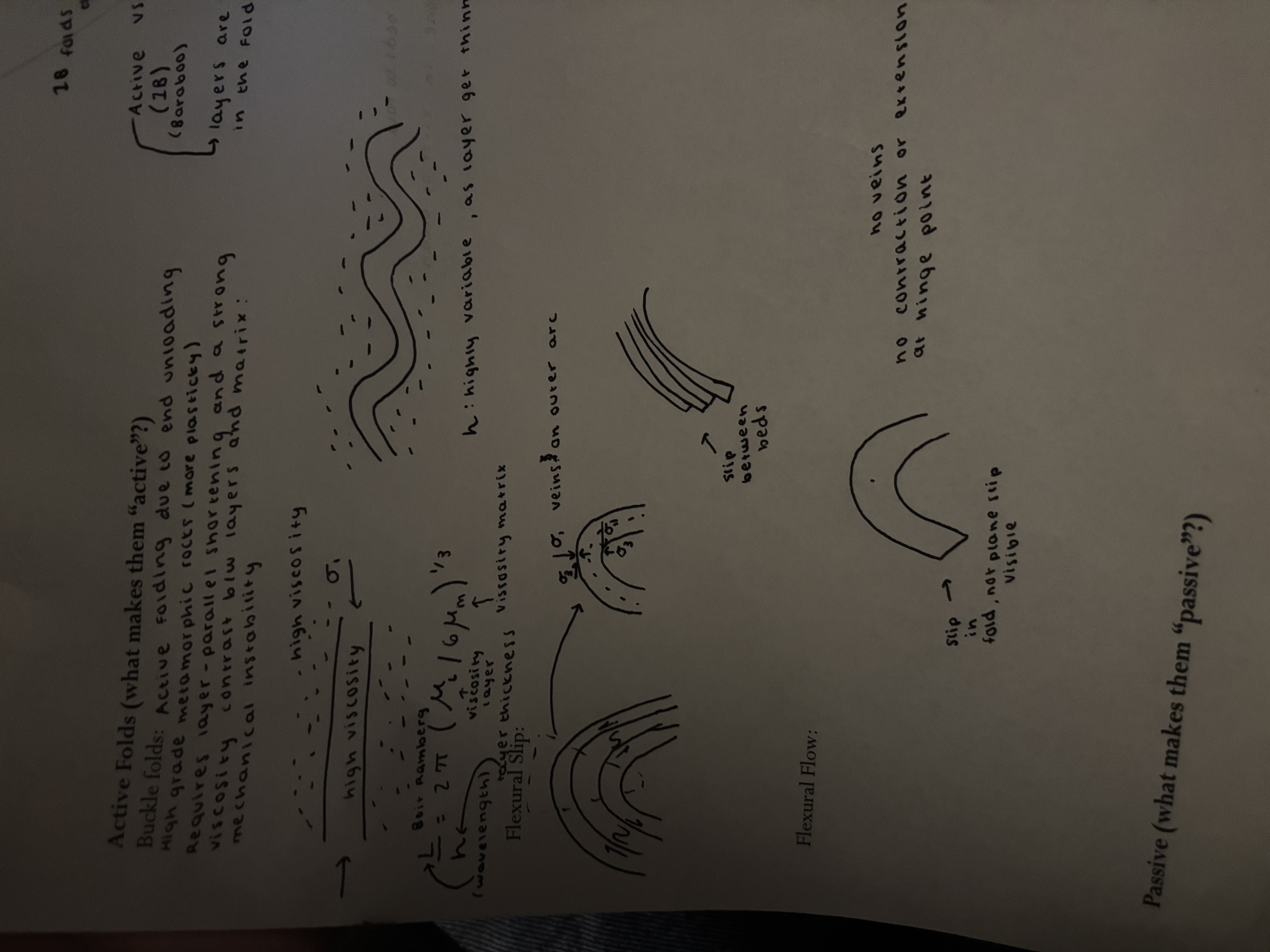
Flexural flow
No visible slip between beds, no contraction or extension, slip is in the fold.
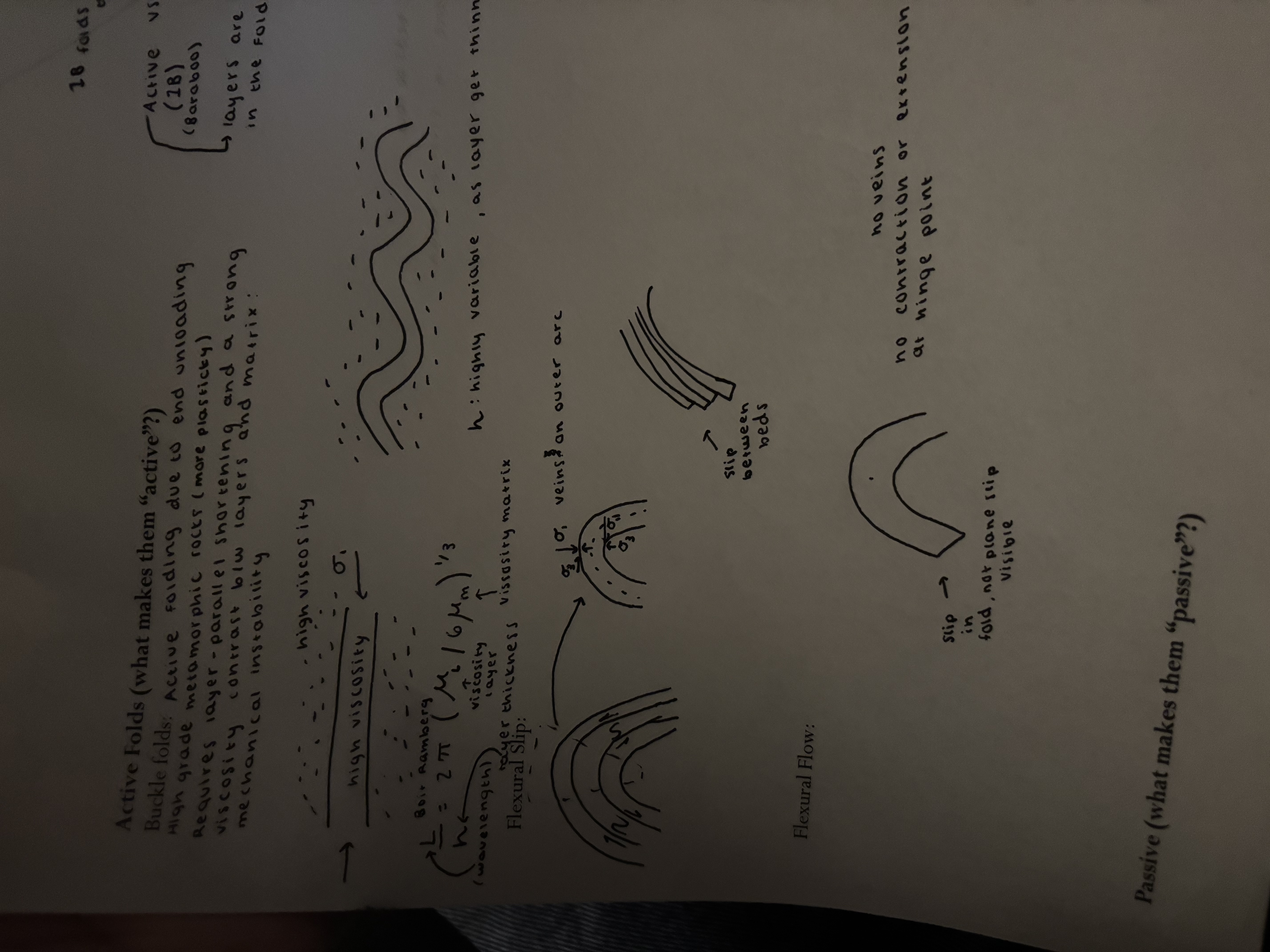
Forced Folds/Bending
Fold shapes required (forced) to form as the result of other geologic processes, forces act across layer. Intrusion forces beds to fold, or could be dripstone in river or ocean.
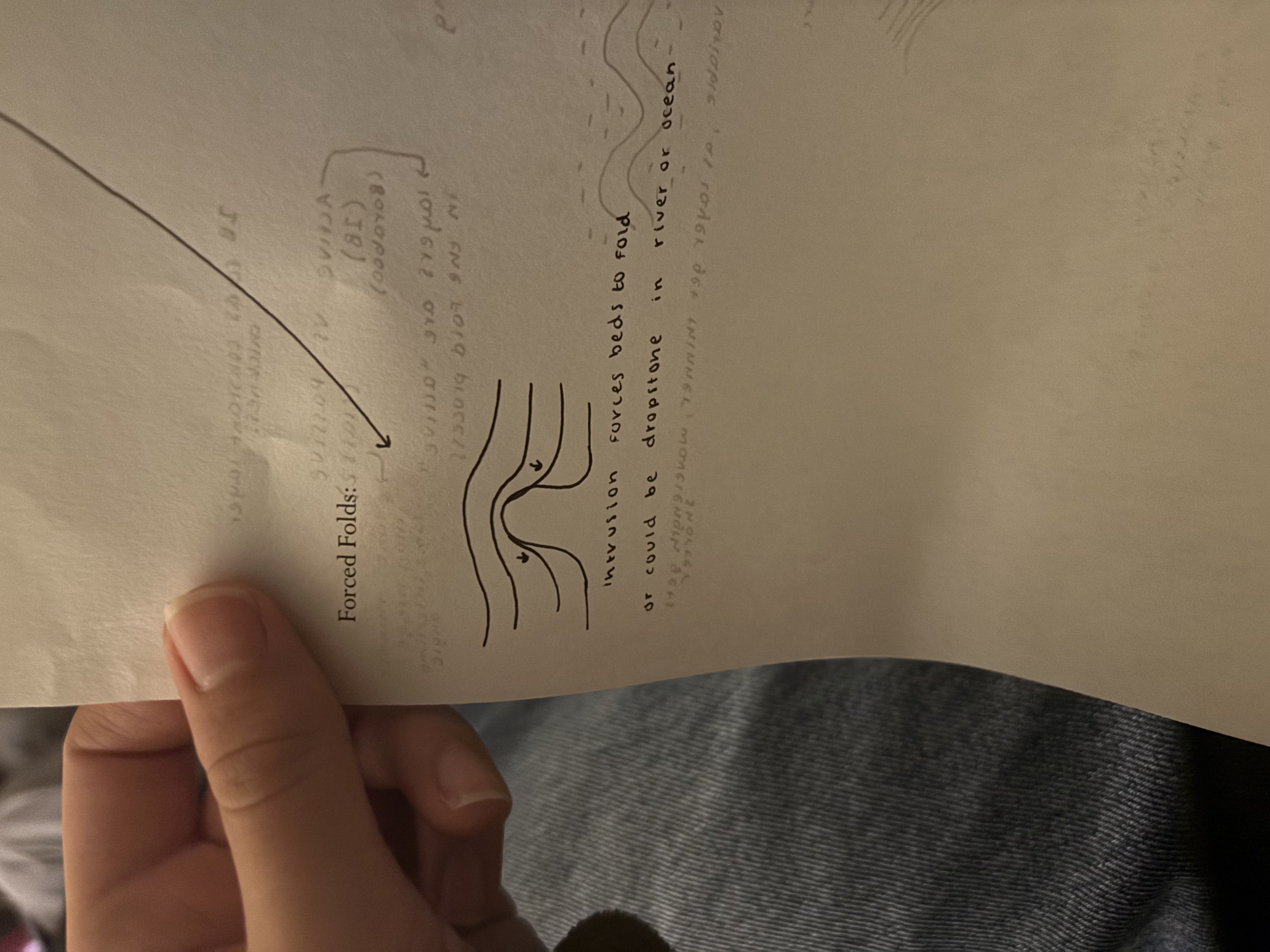
Shear folding
Axial plane (surface)
Inclined (dip), recumbent (horizontal), upright (vertical)
Antiform
upside down U shaped
Synform
U shaped
Anticline
convex towards younger rock
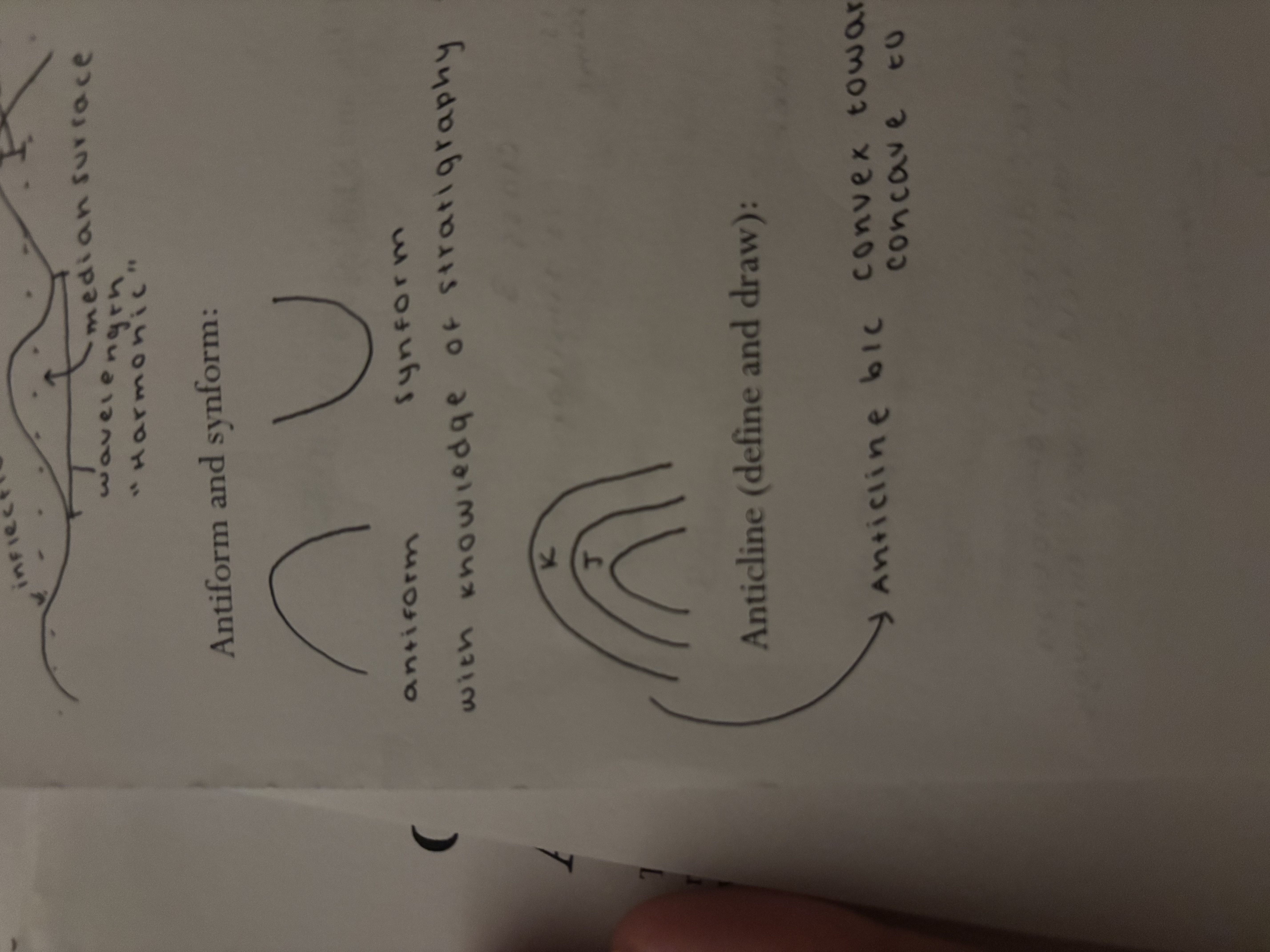
Syncline
convex towards older rock
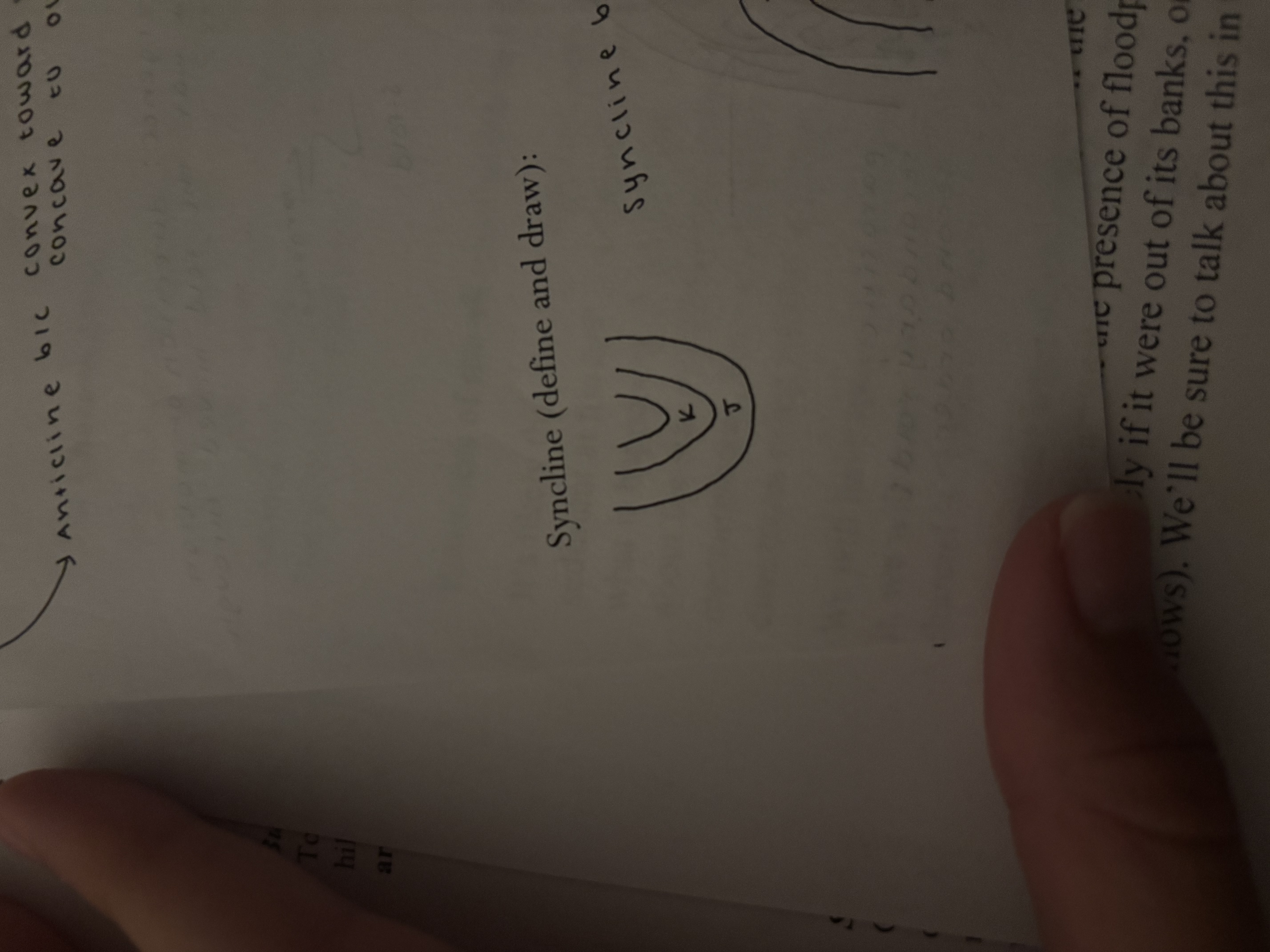
Monocline
Step like fold, only one limb
Dip Isogon
parallel dip
Class 1B
Constant unit thickness
Class 2
Outerarc and Innerarc angles are the same, limbs are thinner
Vergence
direction of motion, how was the fold moved through time
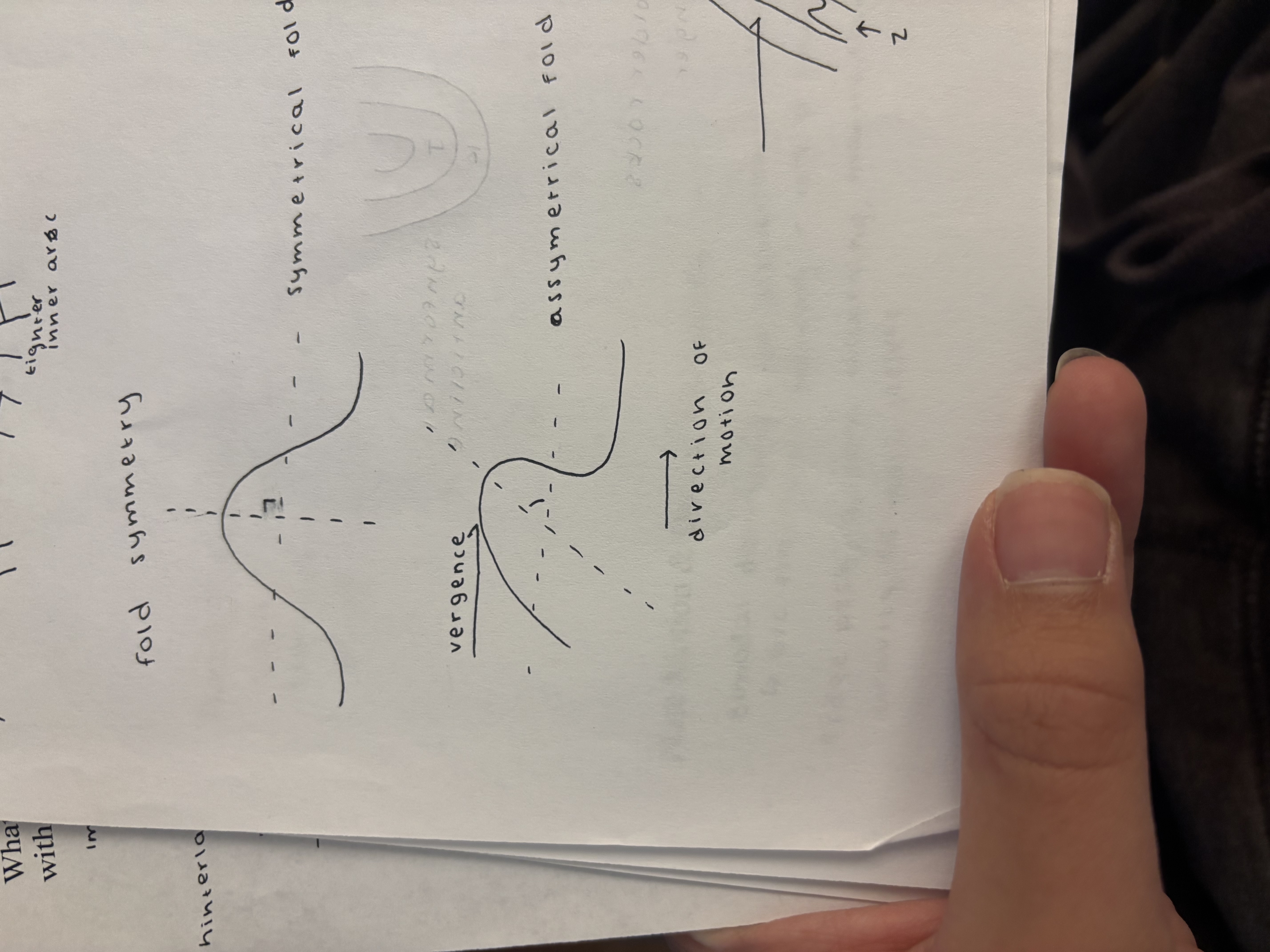
Z folds, S folds
Parasitic, second order folds
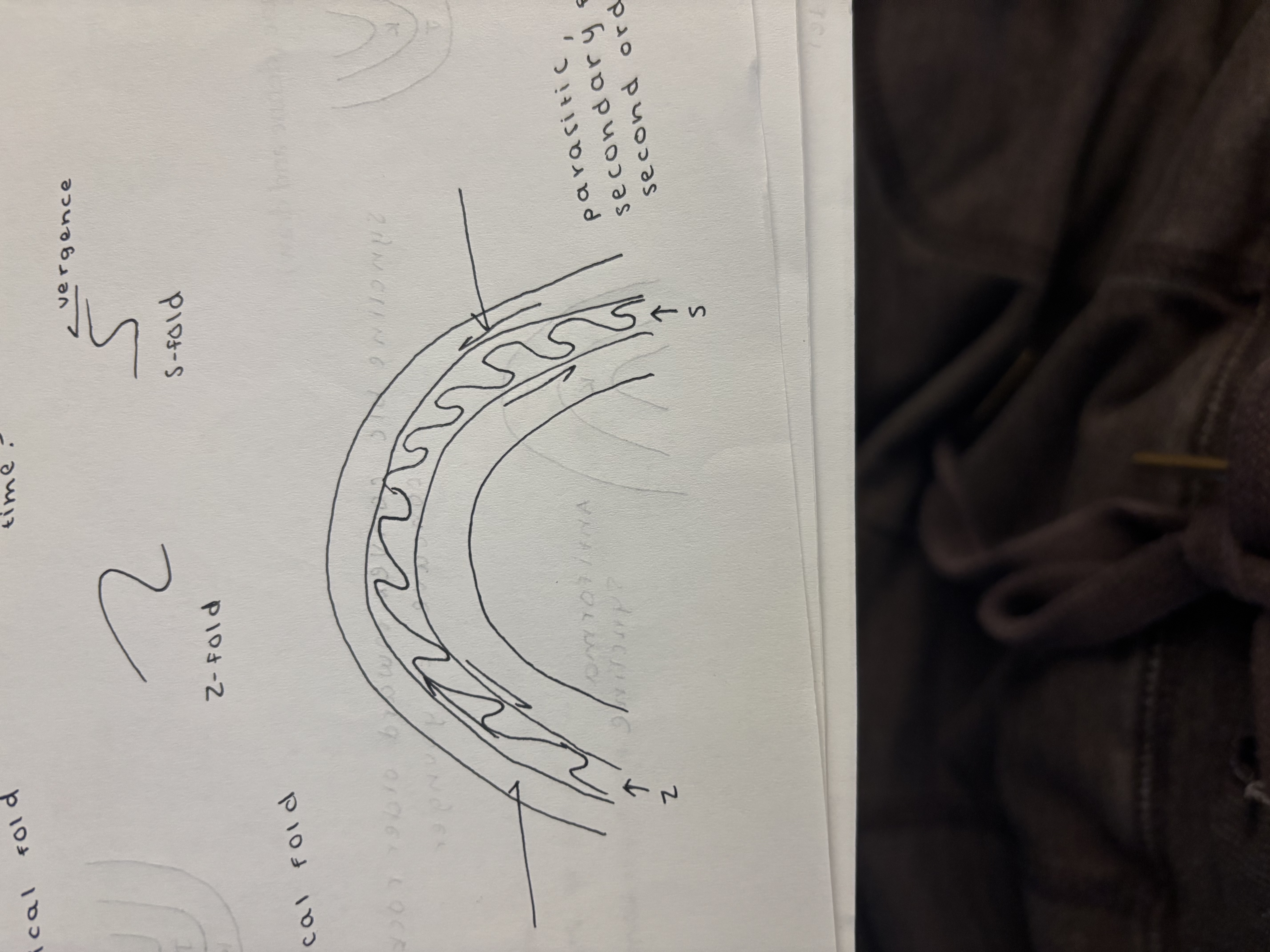
Cylindrical
hinge line is straight
non cylindrical
hinge line is curved
gentle inter limb angle
180-120
open inter limb angle
120-70
tight inter limb angle
70-30
isoclinal inter limb angle
30 and less
Window
Erosional exposure of the rock unit underlying a Nappe
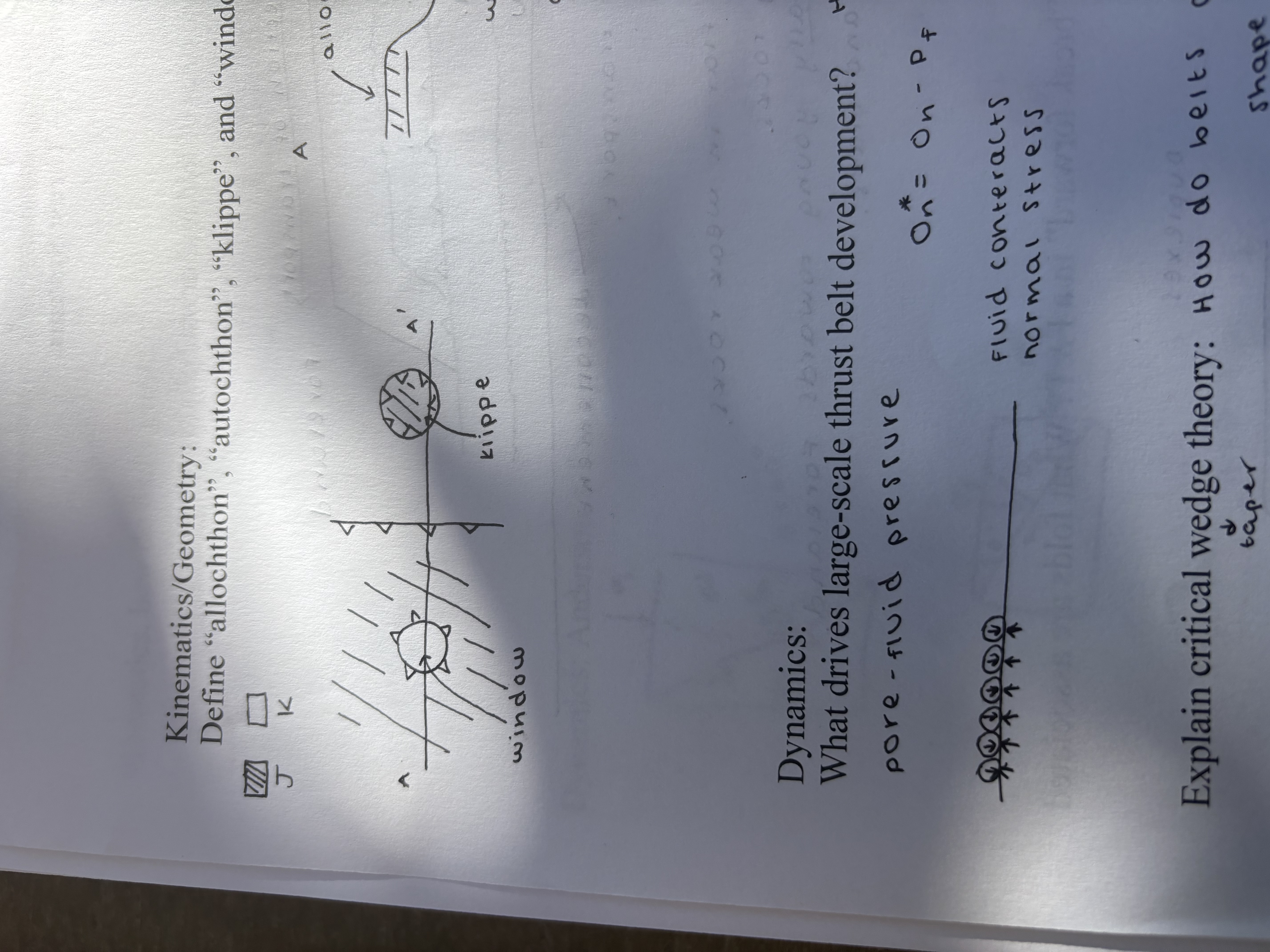
Vein
extensional fracture filled with minerals
Klippe
an erosional remnant of a thrust Nappe
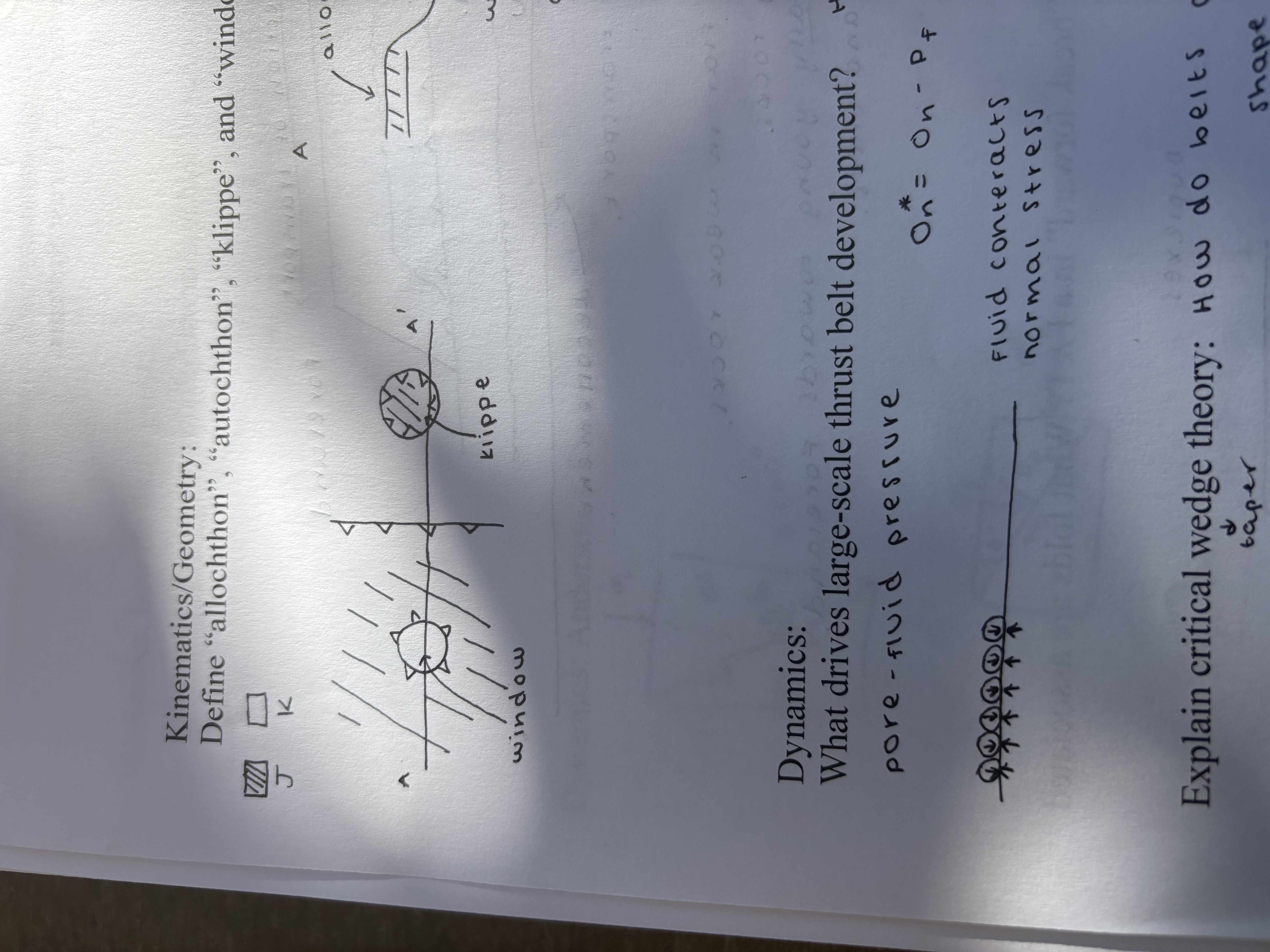
Ribs and rib marks
Elliptical structures occurring on extension fractures, centered on the nucleation point of the fracture They are ridges or furrows where the fracture has a slightly anomalous orientation and are perpendicular to hackle marks
allochthon
Tectonic unit that has been transferred too far for direct correlation with the substrate
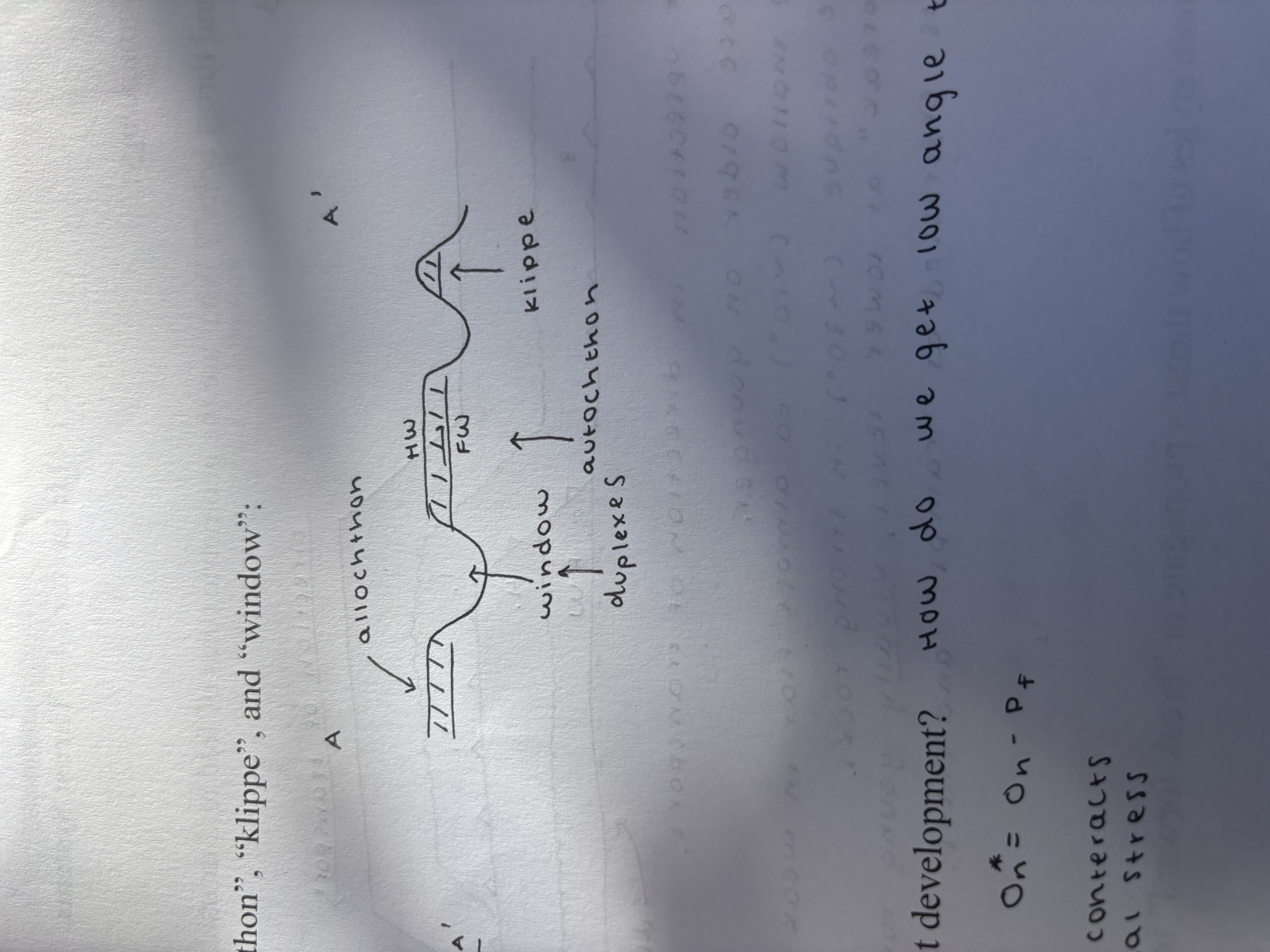
autochthon
lithologic unit in or along an orogenic belt that has not been tectonically transported
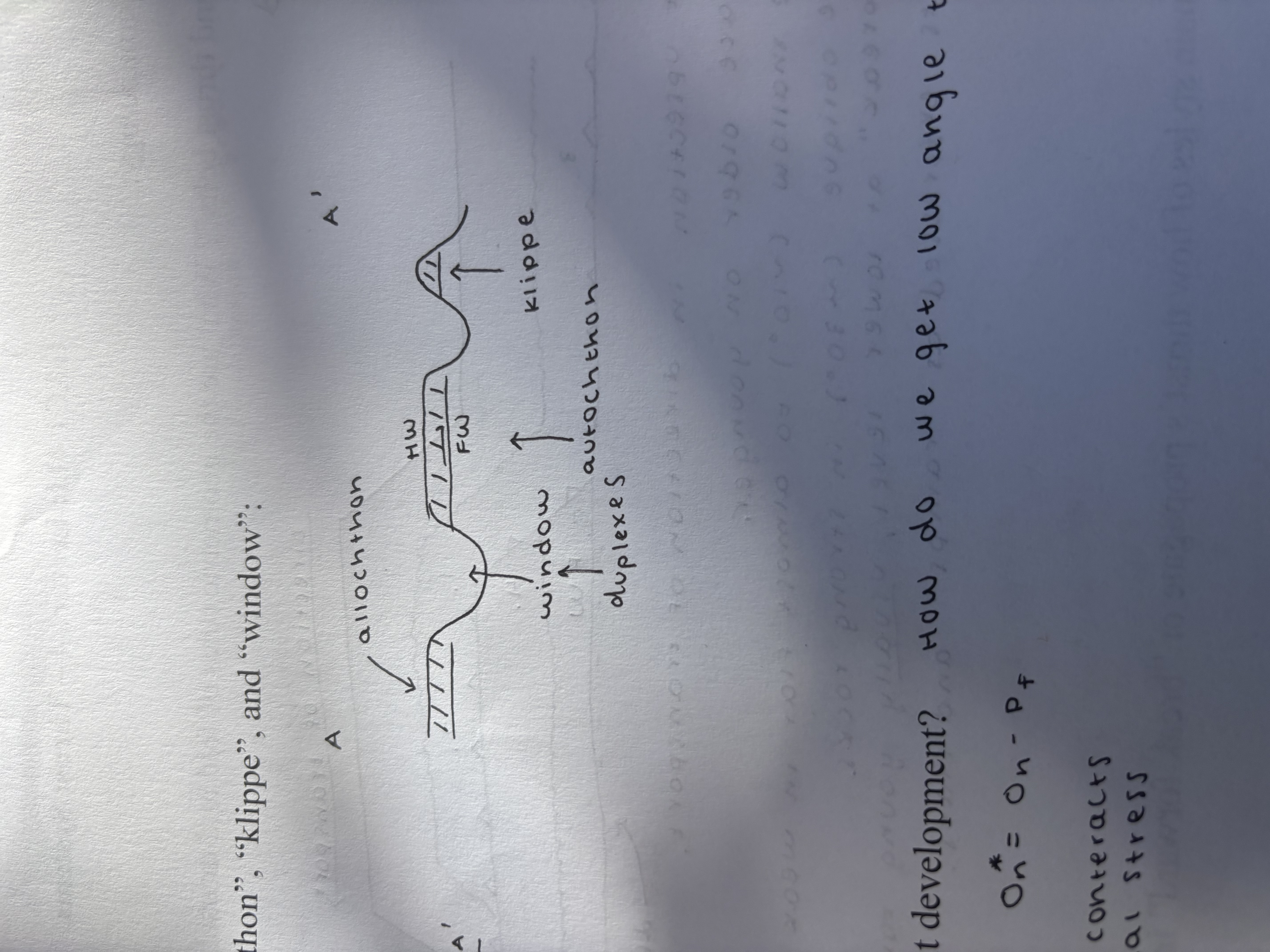
Structural Geology
The geometries of rocks after a process has altered their appearance from an original state. Rock deformation.
Tectonics
The regional processes and motions that generate a set of structure in an area (observer defined)
The composition of Earth and Crust (whole earth)
Fe-35%, O-30%, Si-15%, Mg-13%, NI,Ca,S,Al
Crust composition
Plagioclase-39%, Alkali Feldspars, Quartz, Pyroxenes-12% each, amphiboles, micas, clays
Why is crustal composition important?
Explains faulting and fracturing
Compositional layers of the earth
Crust, mantle, core
Rheological layers
lithosphere, asthenosphere, mesosphere, outer core, inner core
Continental crust
40 km thick on average, oldest rock in 4ga, less dense, 5-10x thicker than ocean crust, avg. age 2.6-2.7 ga
Composition an characteristics of oceanic crust
Basalt and gabbro, younger - no older than 200ma, thinner
Lithosphere vs. asthenosphere
l - rock, implying strength; plates70-10km thick in ocean, 200-225km thick continental a- 660km, plasticky
Tectonic plates of earth
deepest earthquakes happen at subduction zones, earthquakes trace plate boundaries, plates can be oceanic and continental
Plate motion and driving mechanics
Bimodal distribution of elevation, density contract, this is because of fractional melting and water. Mechanisms are ridge push, slab pull, mantle flow, plume push, crustal thickening, gravity is main driver.
Difference between primary structures and secondary structures
primary structures develop during the formation of a rock body, we want to know this so we can figure out what a rock looked like in its original state, this helps u orient ourselves.
Sole/tool marks/flute casts
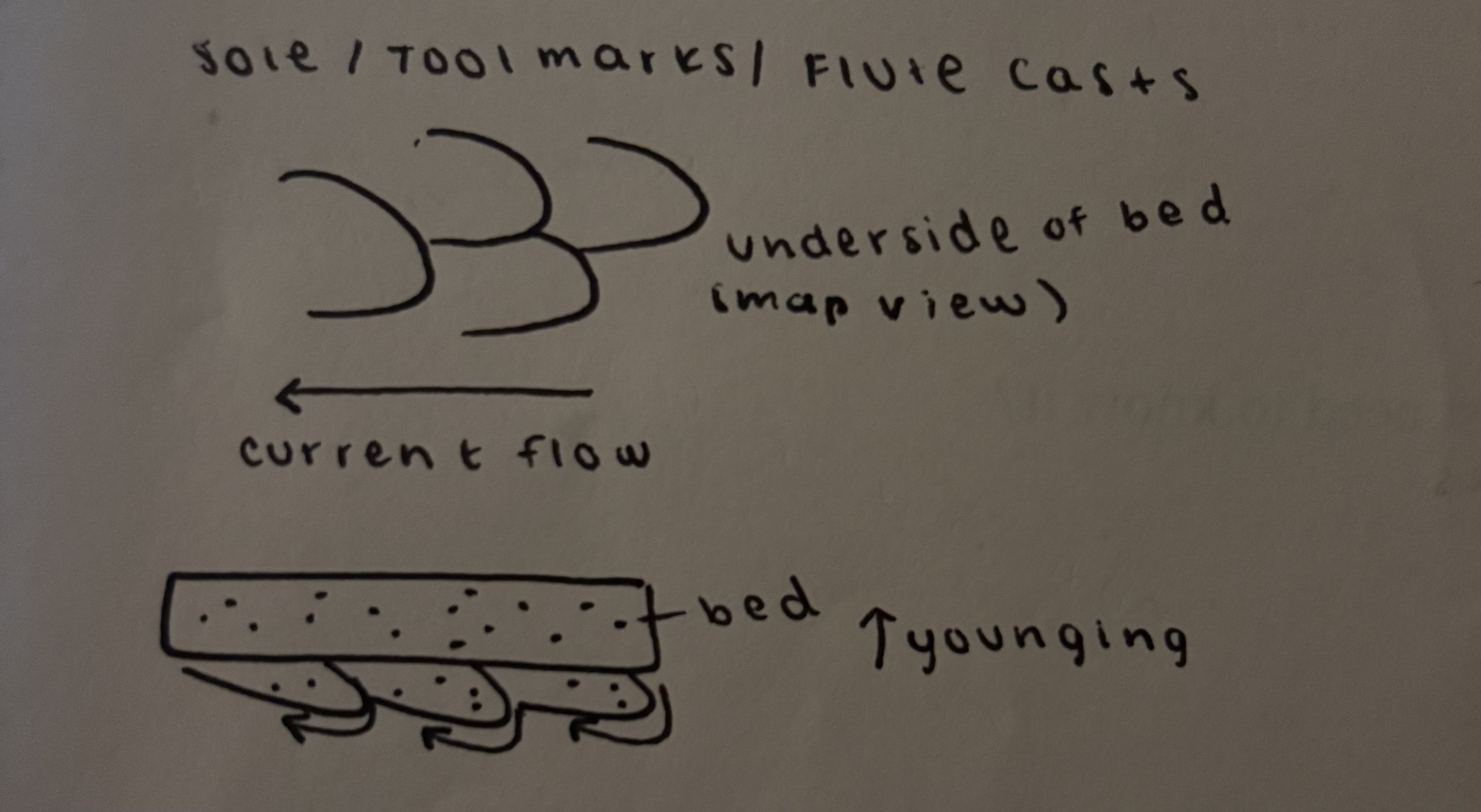
Ripple marks
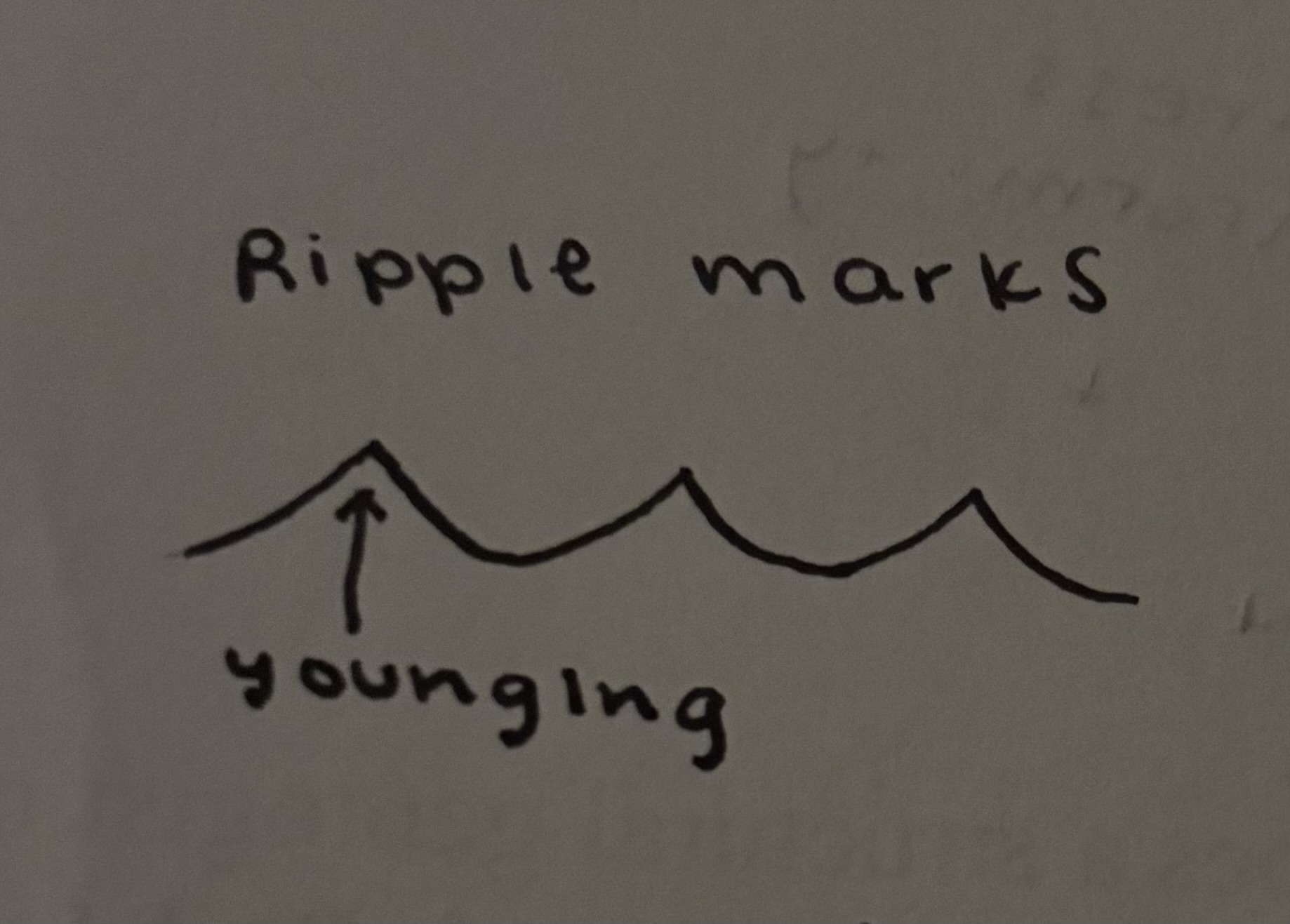
Cross bedding/cross stratification
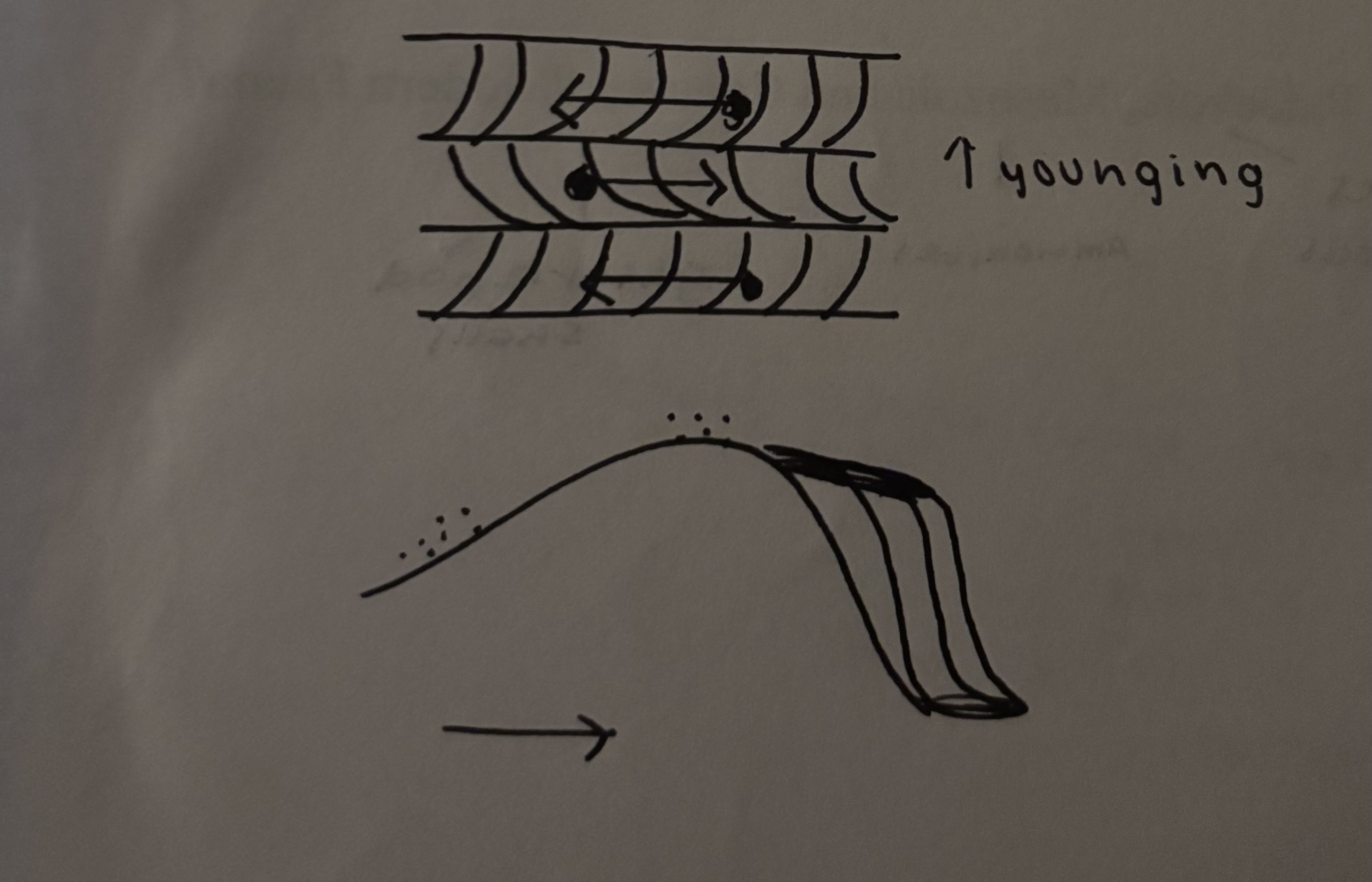
Graded bedding

desiccation/mud cracks
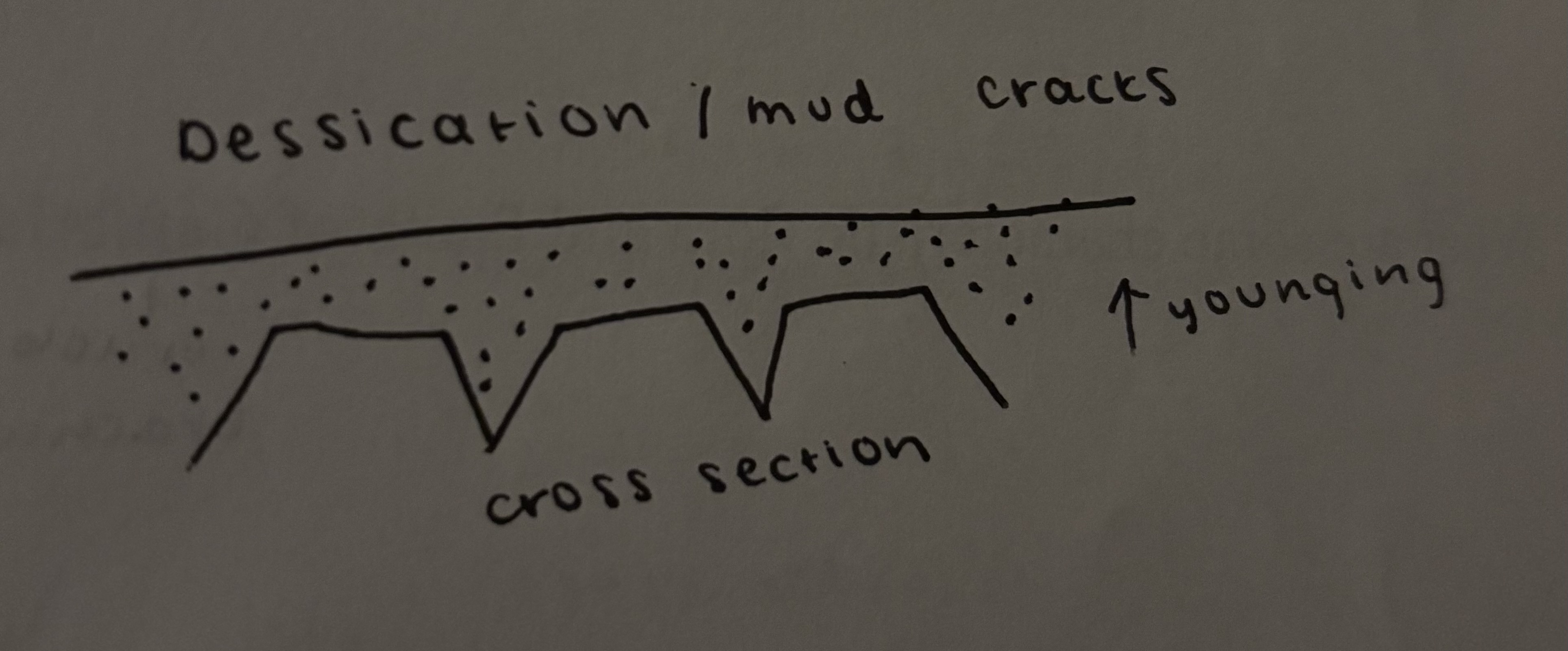
Buttress unconformity
younger sedimentary rocks are deposited against an older, topographically irregular surface. This results in the younger rocks abutting or "buttressing" the older rocks, creating a distinct angular relationship between the two sets of layers.
nonconformity
sedimentary rock on top of igneous or crystalline base rock
discomformity
sedimentary on sedimentary rock, bottom layer is eroded
angular unconformity
horizontal eroded, tilted, meet at an angle
paraconformity
time missing
Characteristic fauna and flora of Cambrian
Trilobites
Characteristic fauna and flora of Paleozoic
brachiopods
Characteristic fauna and flora of Mesozoic
ammonites
Characteristic fauna and flora of Cenozoic
gastropod shells
Difference between sigma 1 and sigma three
sigma 1 is greatest, sigma 3 is least
Griffith cracks and tensile crack formation
In the lab ideal material fracture at 10gpa, real rocks have micro defects - micro fractures
Griffith fracture theory
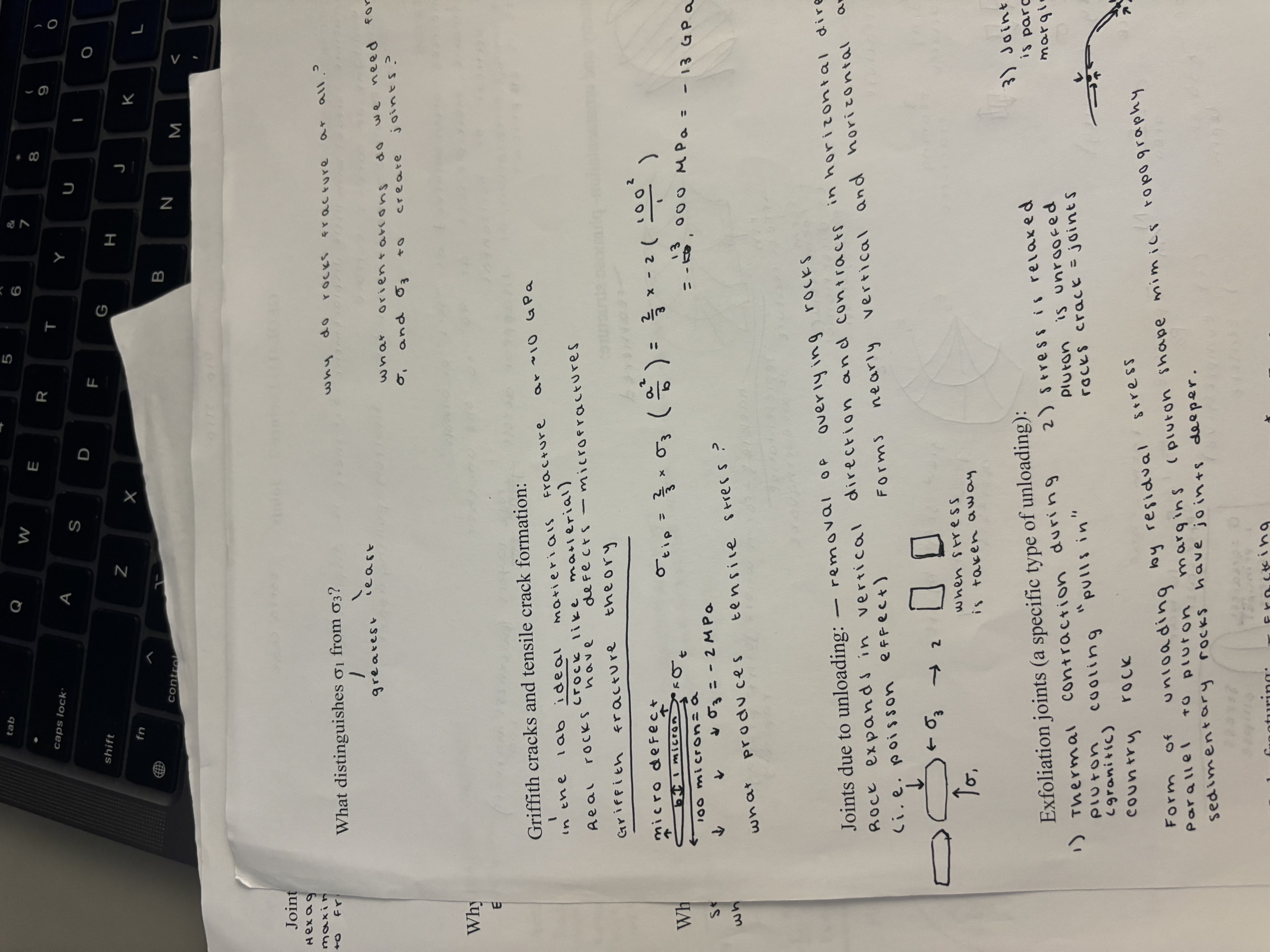
Joints due to unloading
removal of overlying rocks, rocks expand in vertical direction, contract in horizontal direction, form nearly vertical and horizontal arrays
Joints
Fracture with little displacement, abundant on surface of earth, tensile feature, formed by dilation
Joint Arrays
Often observed as sets or arrays, systemic, multiple sets 90 degrees from each other, vertical or horizontal, refract, change orientation or disappear along rock layers (thickness matters too)
Plumose Structure
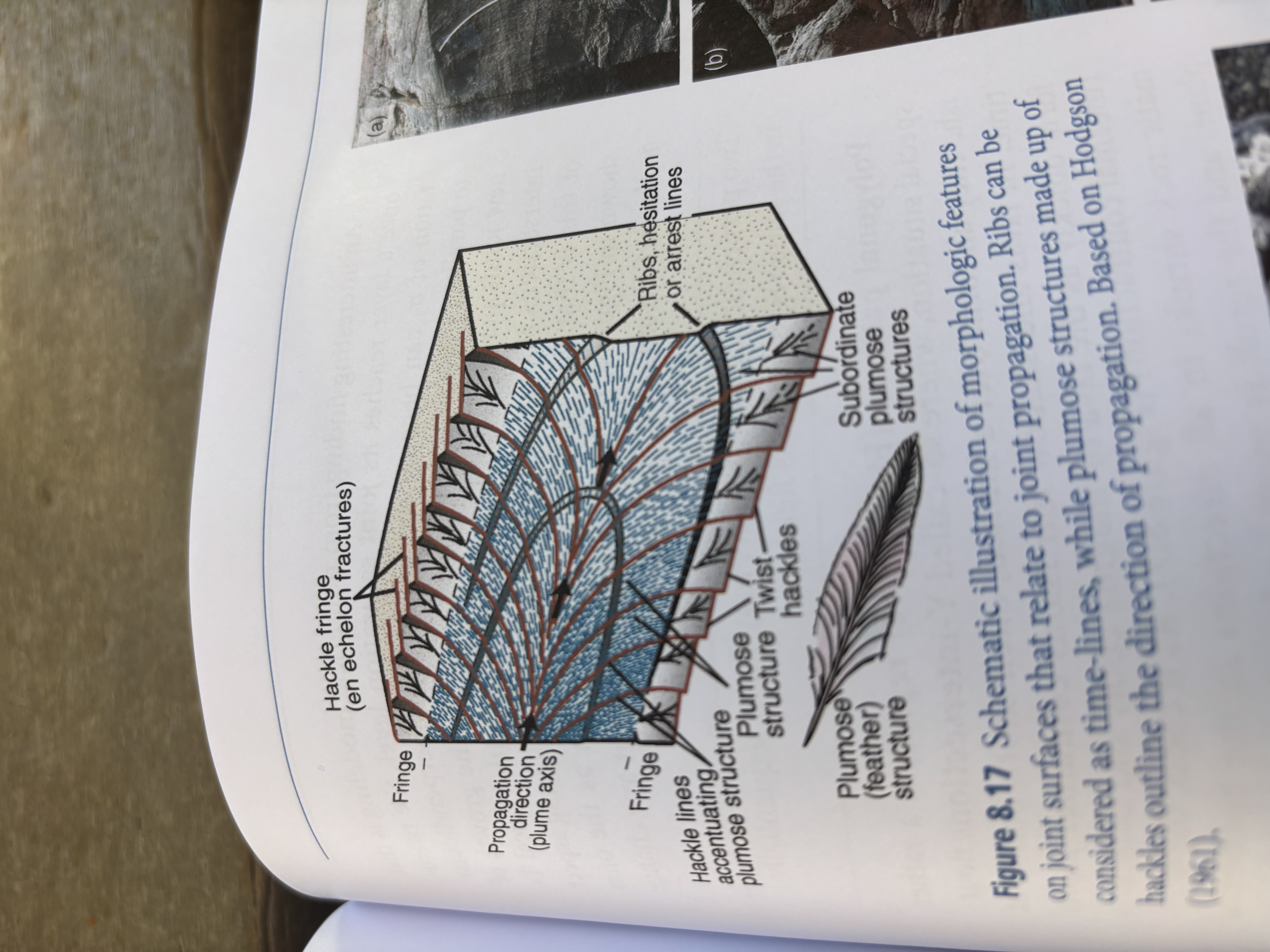
Hackles
Form where joint propagates rapidly
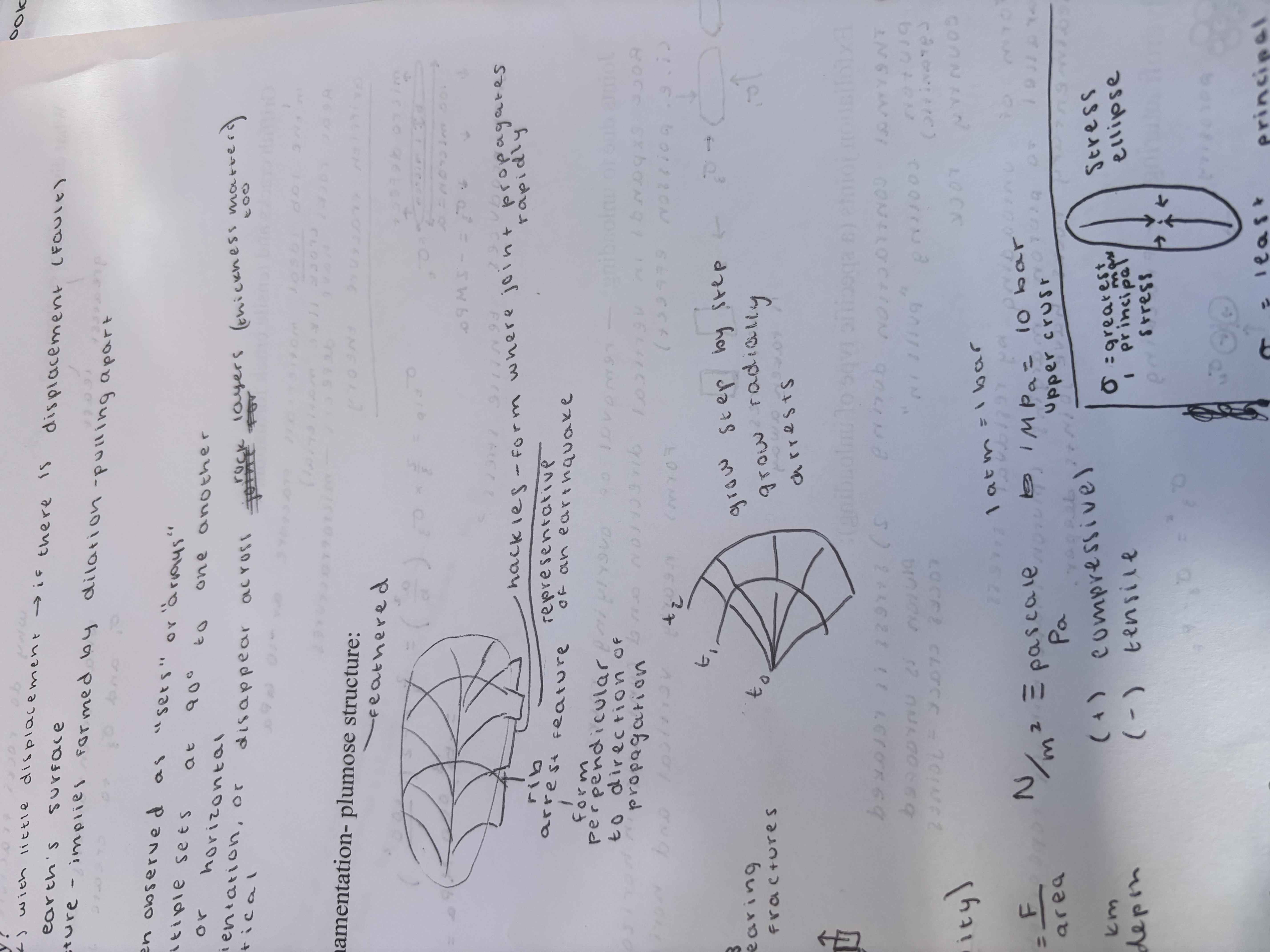
Modes of Fracture
Opening fractures (joints)
Sliding fractures
Tearing fractures
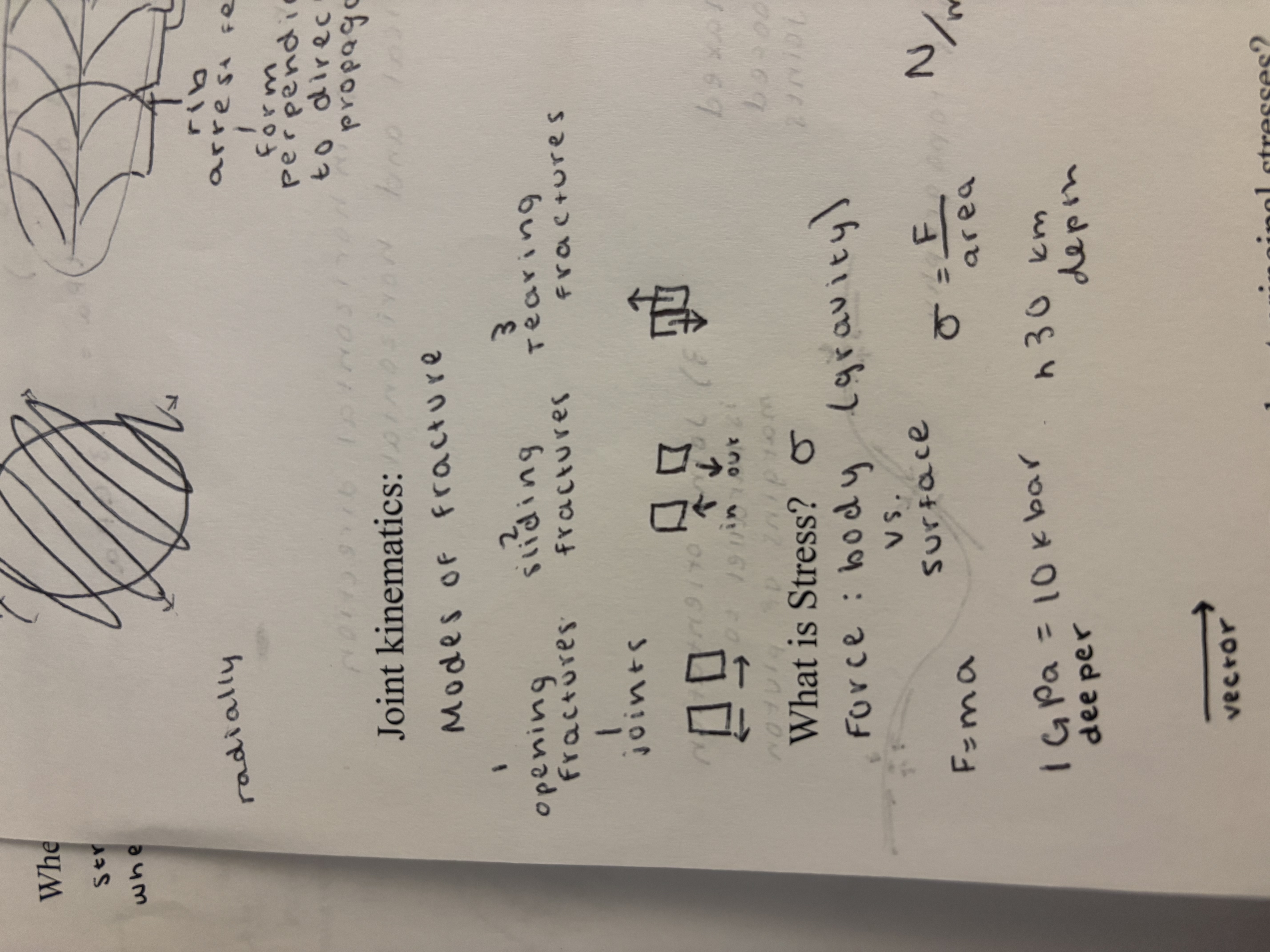
Exfoliation joints
Thermal contraction during pluton cooling “pulls in” country rock
Stress is relaxed, pluton is unroofed, rocks crack=joints
Joint orientation is parallel to surface and margins of pluton
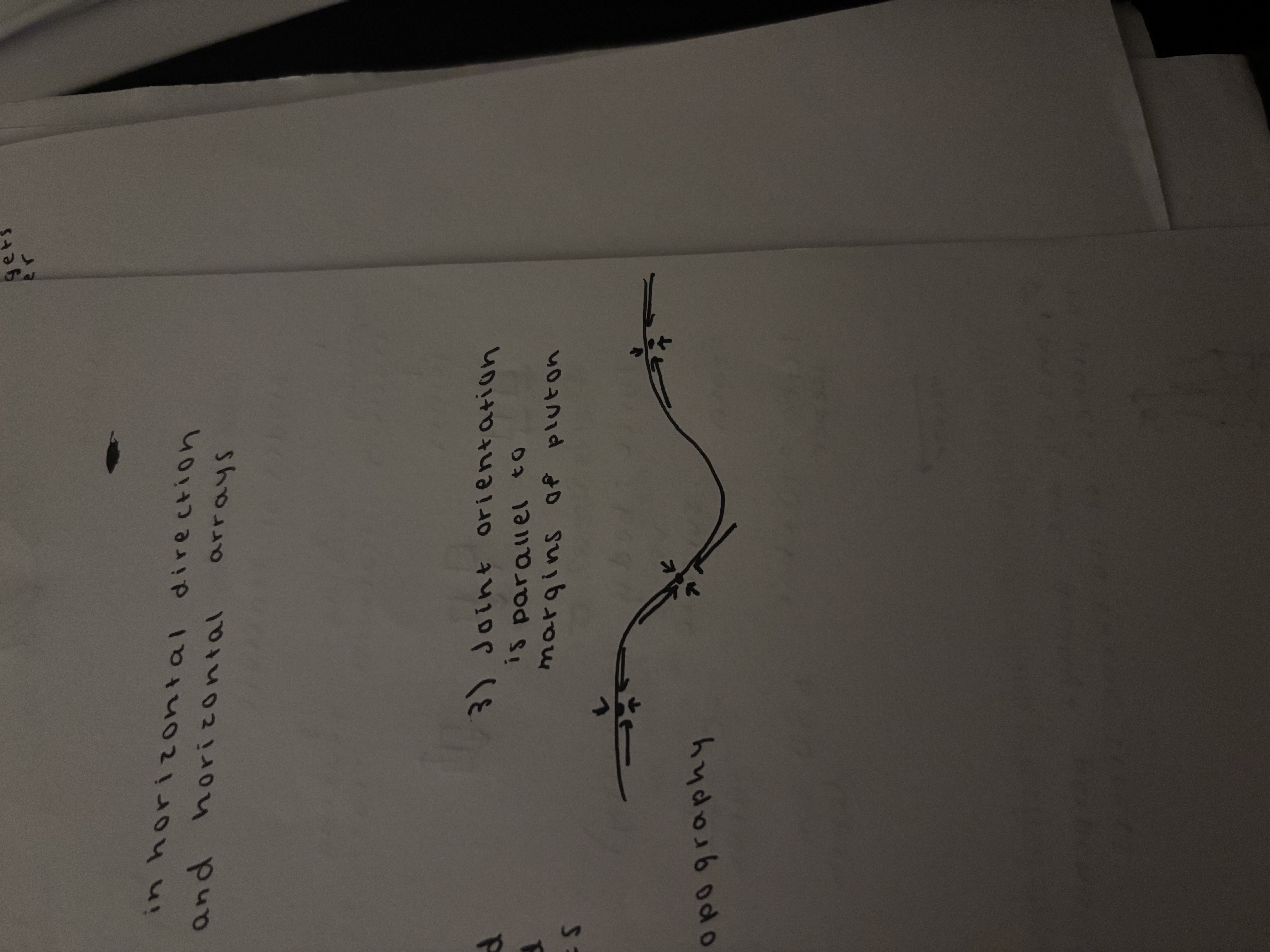
Hydrofracturing
Fracking
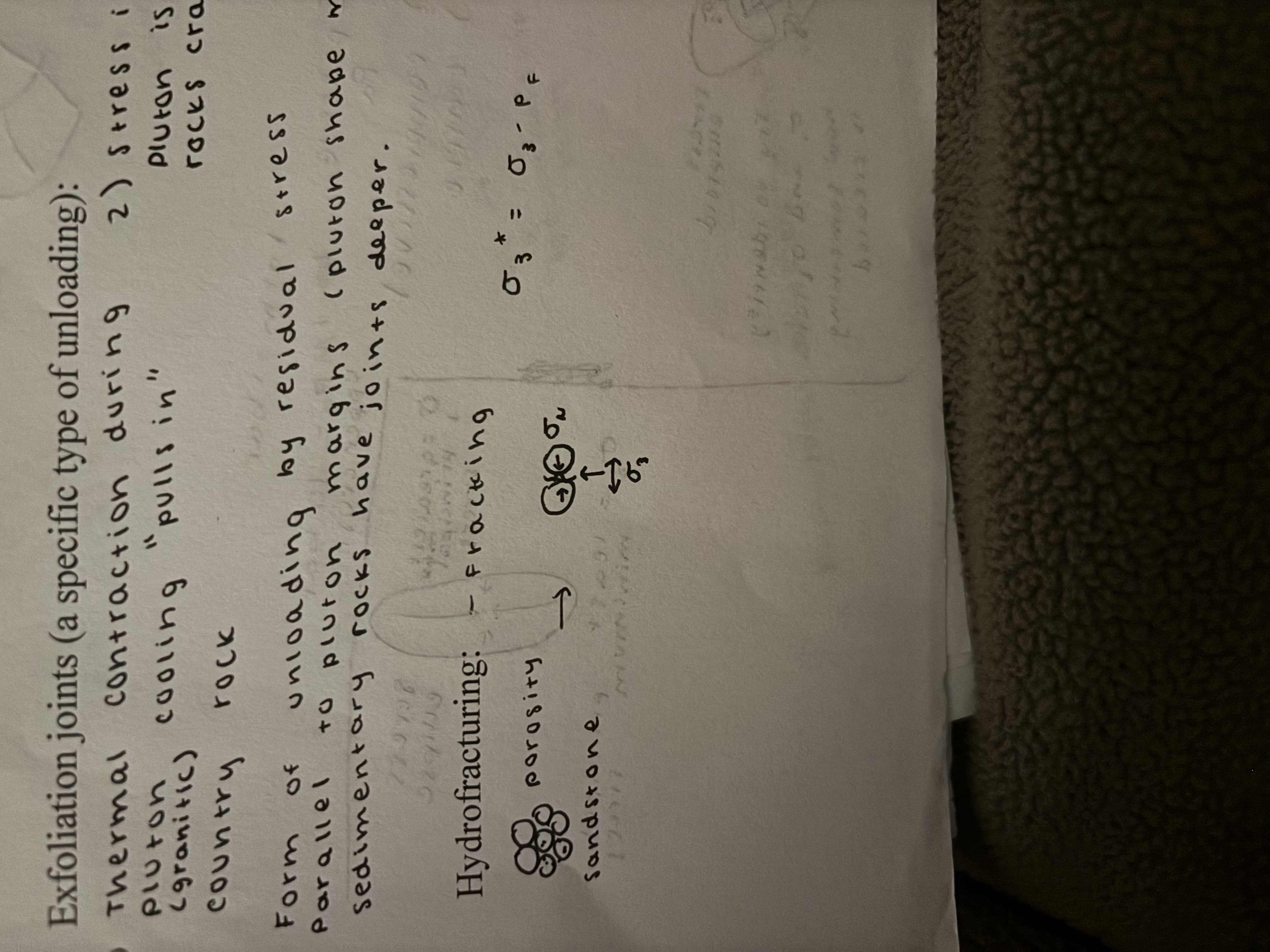
Joints related to thermal contraction
Horizontal Jointing maximizes surface to fracture length ratio (basalts near surface)
Why do joints form near the surface
Stresses become more comprehensive with depth to the points where rocks can’t pull apart
Faults/Shear Fractures
Compressive shear fractures with appreciable displacements
Fault zones
Zone of faults, scale dependent
Slip
Relative movement on opposite sides of the fault, actual total displacement
Seperation
Offset of a marker (i.e. sedimentary beds, dikes, etc), apparent displacement
Normal Fault
If shallow dip, less than 30 degrees it is a detachment, steeper angle is normal fault, generally placed younger rocks and or lower grade rocks (in the hw) on top of older and or higher grade rocks (in the fw), omits stratigraphy, accommodate extension.
Reverse Faults
Shallow dip, thrust fault, older higher grade rocks on younger lower grade rocks, repeats stratigraphy, accommodate shortening
Slicken lines
Provide direction of slip
Chatter marks
Imbricate fan
Contractional faults in the foreland of an orogenic zone typically form an imbrication zone, imbricate fan. It is a series of similarly oriented reverse faults that are connected through a low angle floor thrust.
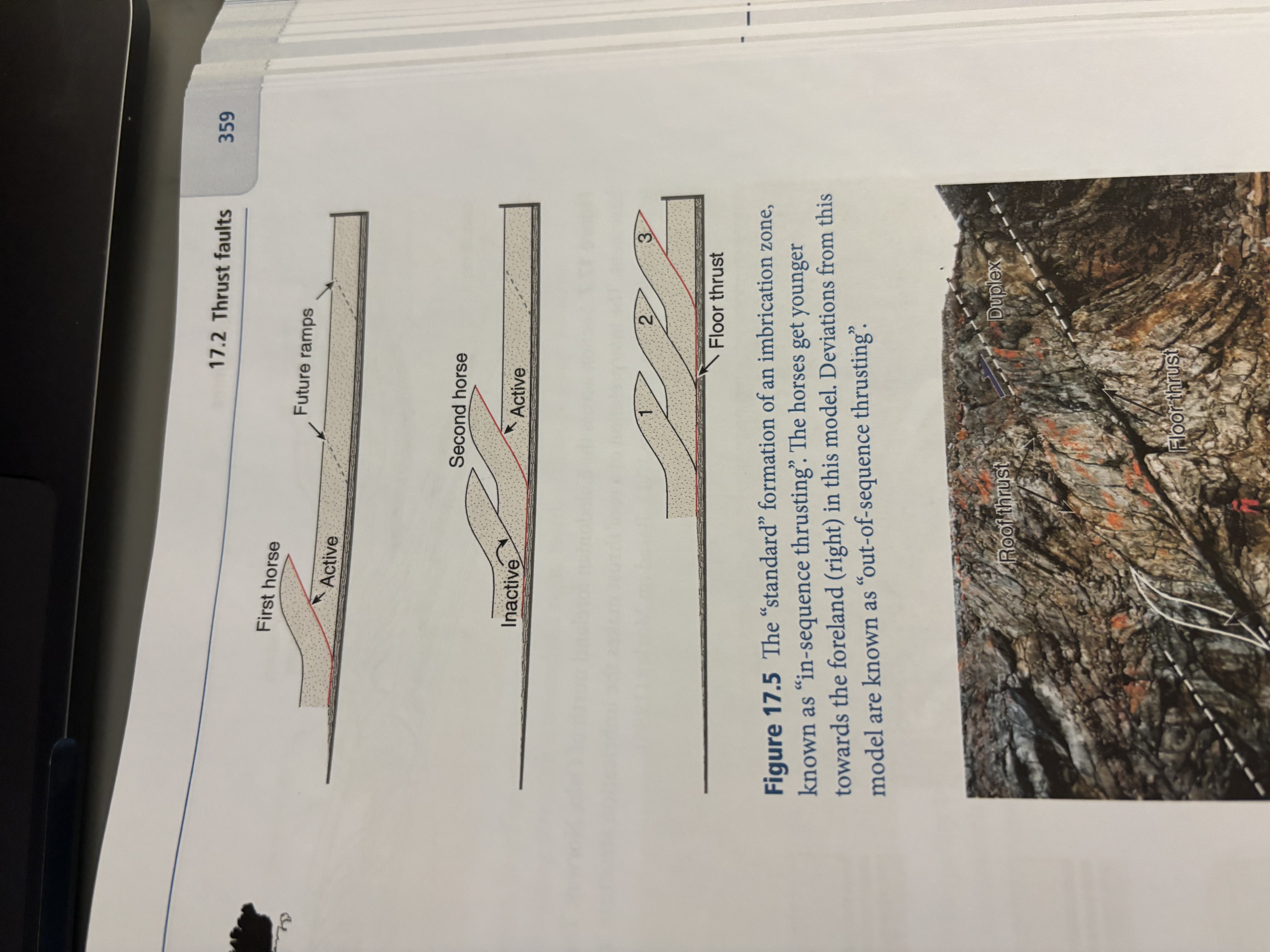
Duplex
An imbricate fan that is bound by a roof structure
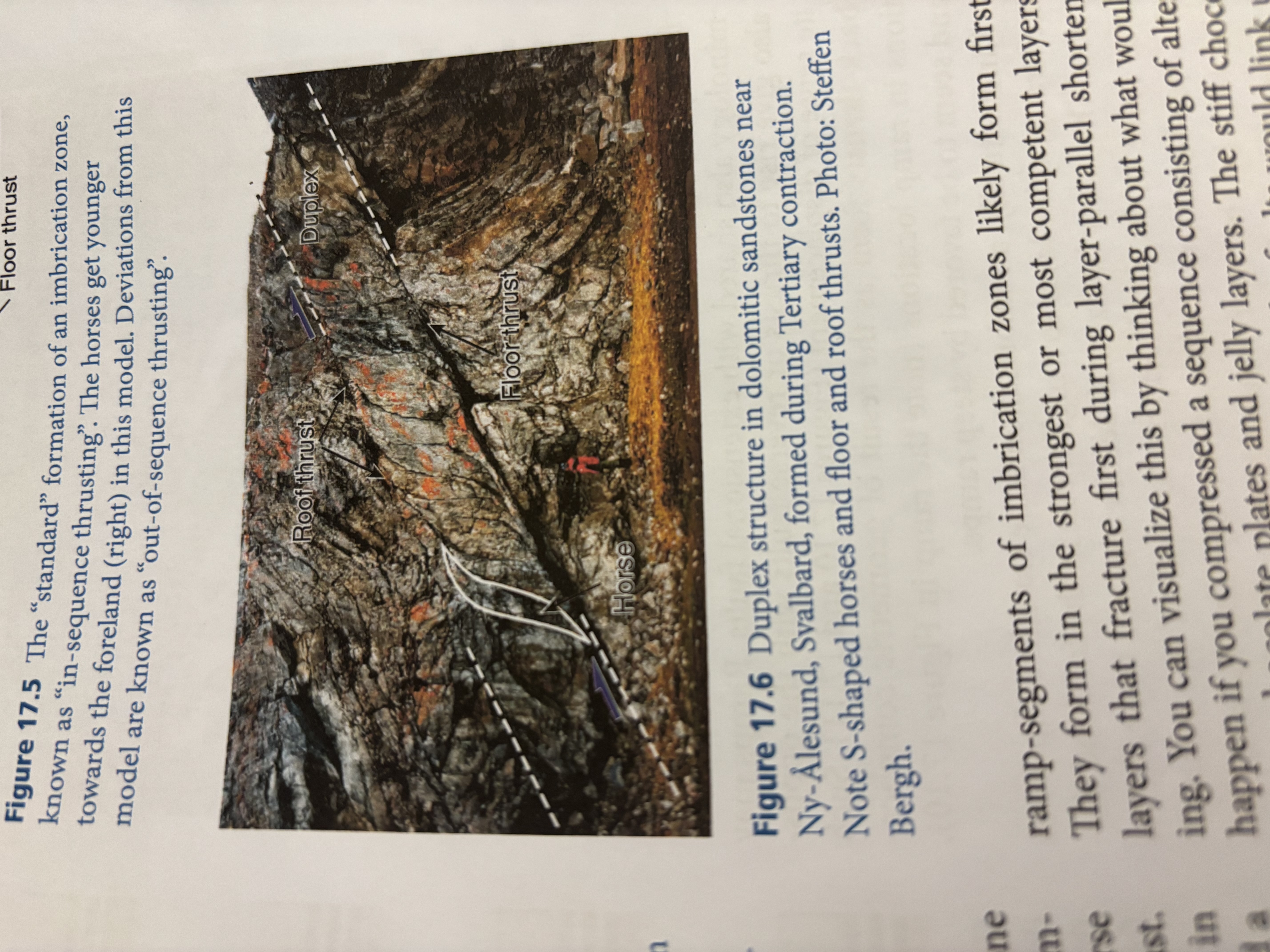
Fault Bend Fold
The moment a ramp is established and the hanging wall starts climbing above it, the hanging wall layers are deformed into a fault bend fold.
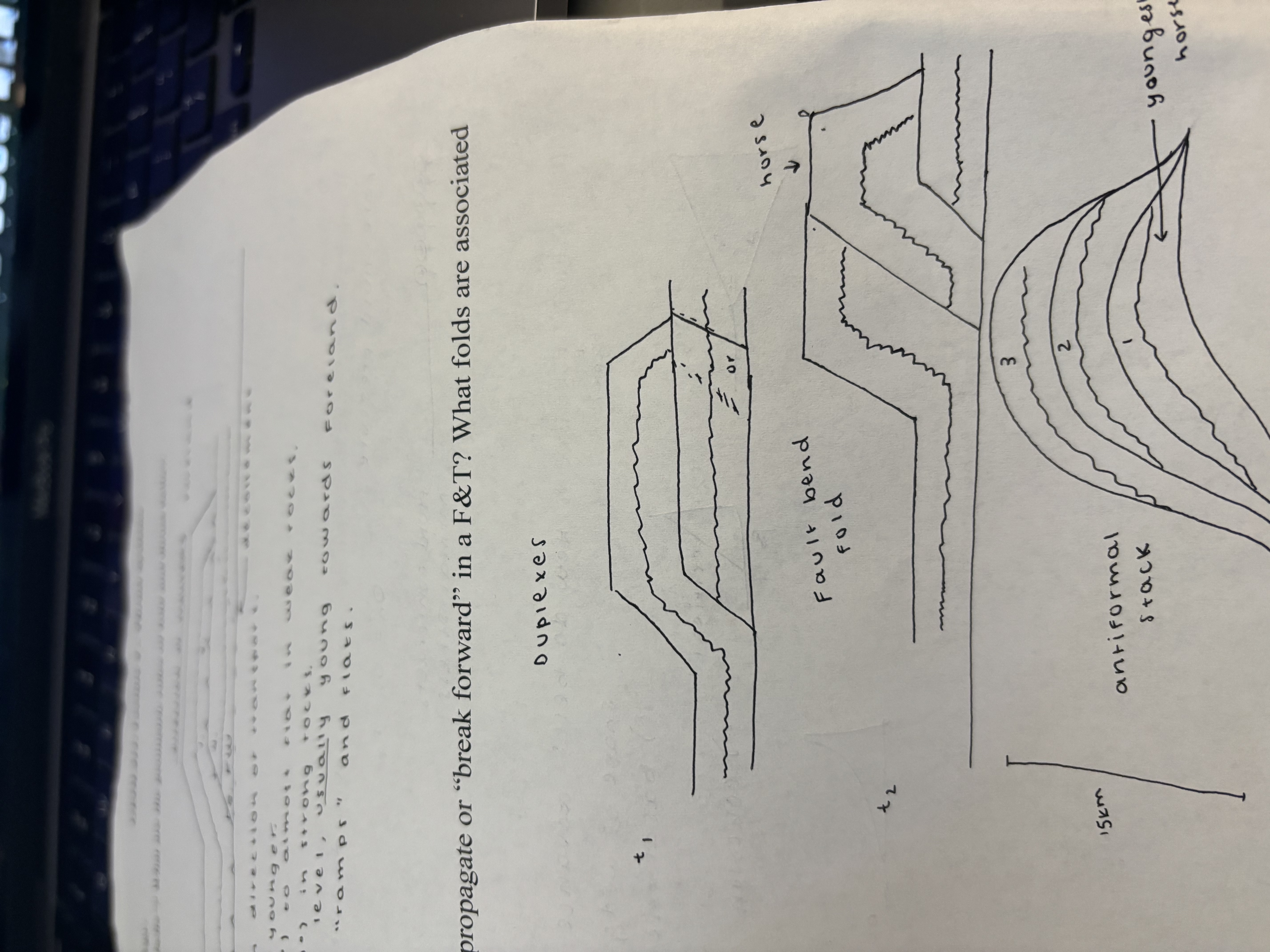
What are fold and thrust belts? What are the geometric rules of fold and thrust belts
Thrusts cut up section in direction of transport
Thrusts place older on younger
Thrusts are shallow ~10 degrees to almost flat in weak rocks
Thrusts are oblique ~30 degrees in strong rocks
Thrusts break at lower level, usually young towards foreland
Thrusts belts expressed as ramps and flats
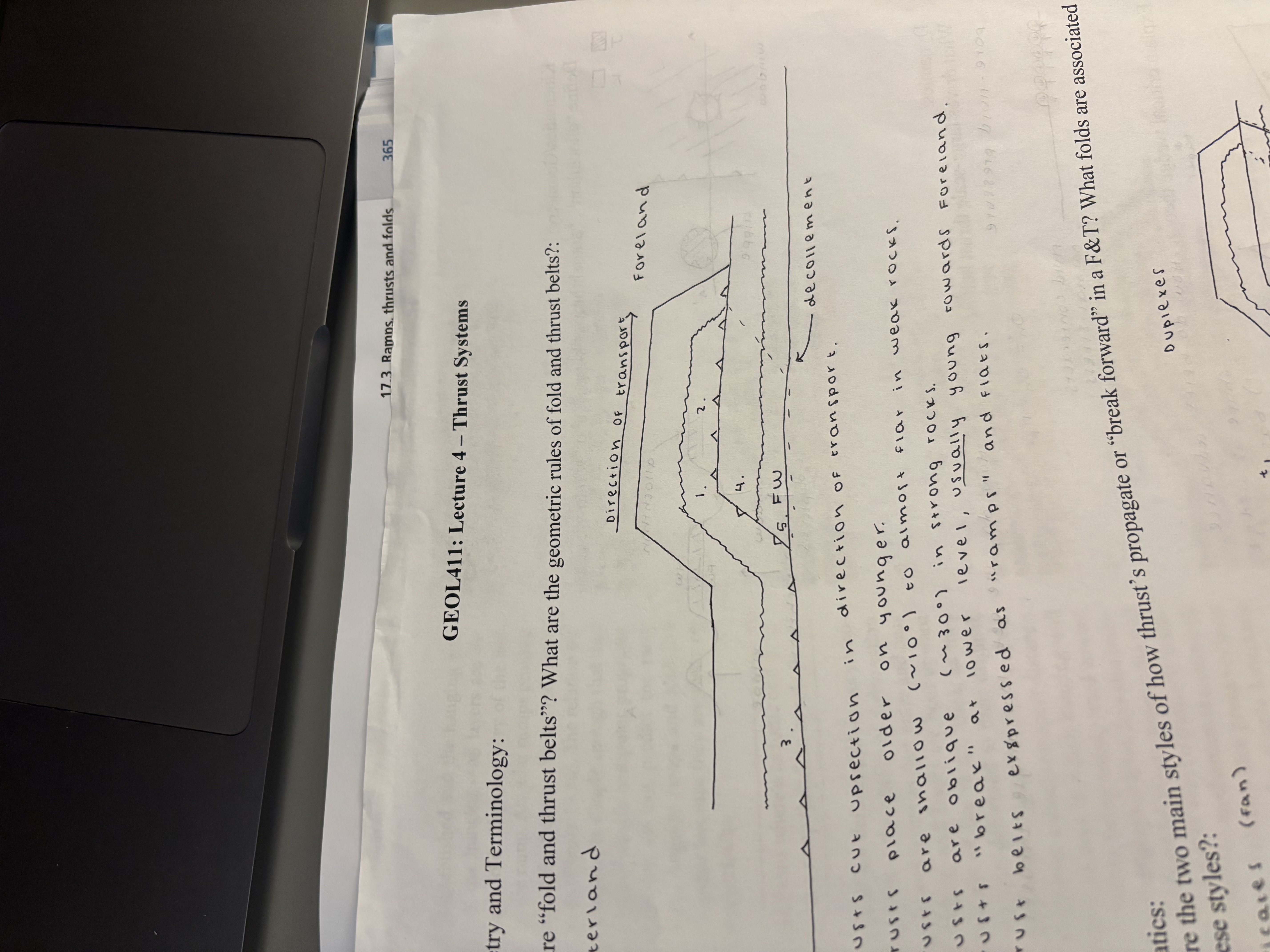
Decollement
Undeformed basement
Detachment
Low angle normal fault
Normal fault Domino
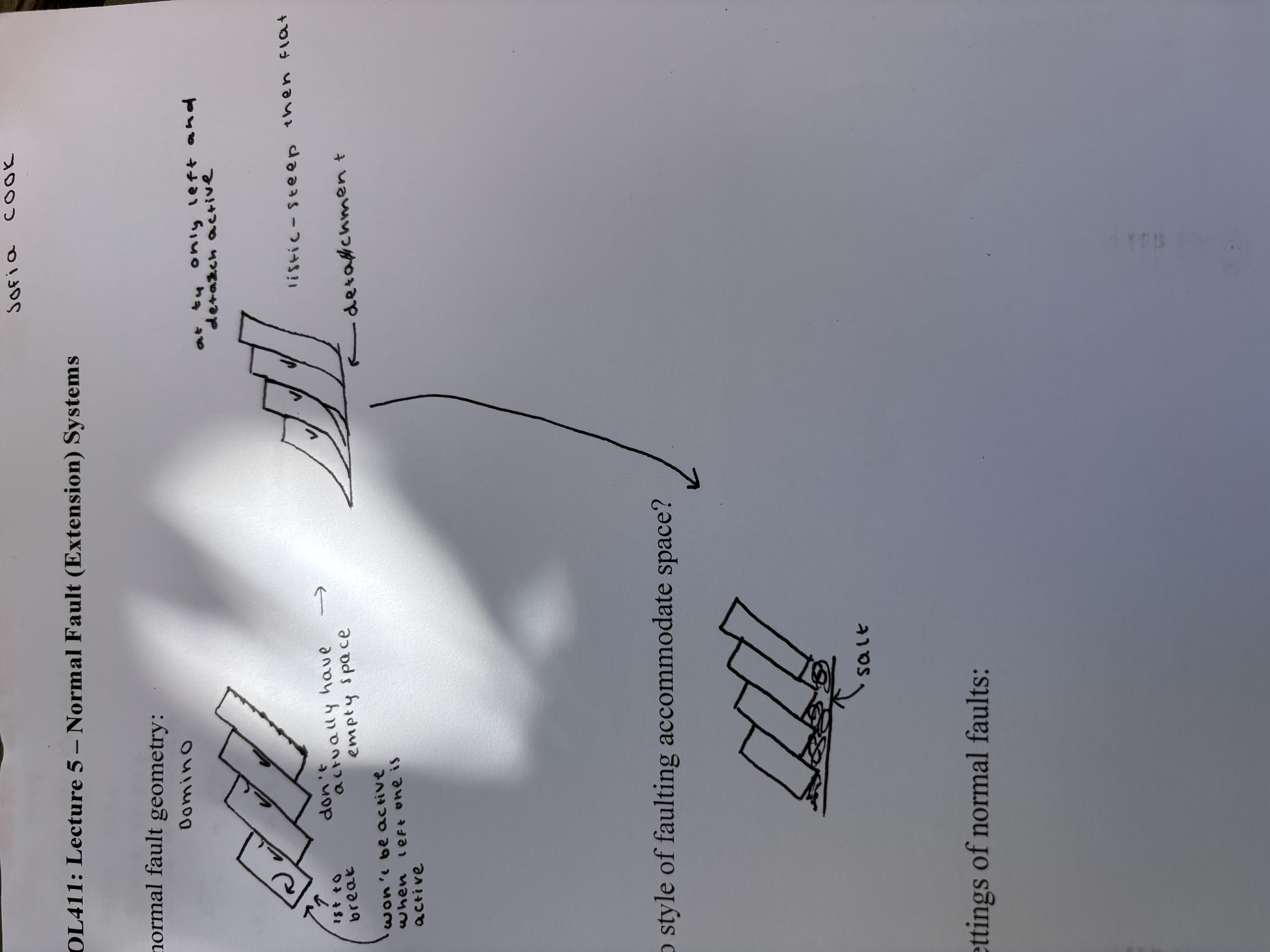
Horst and Graben
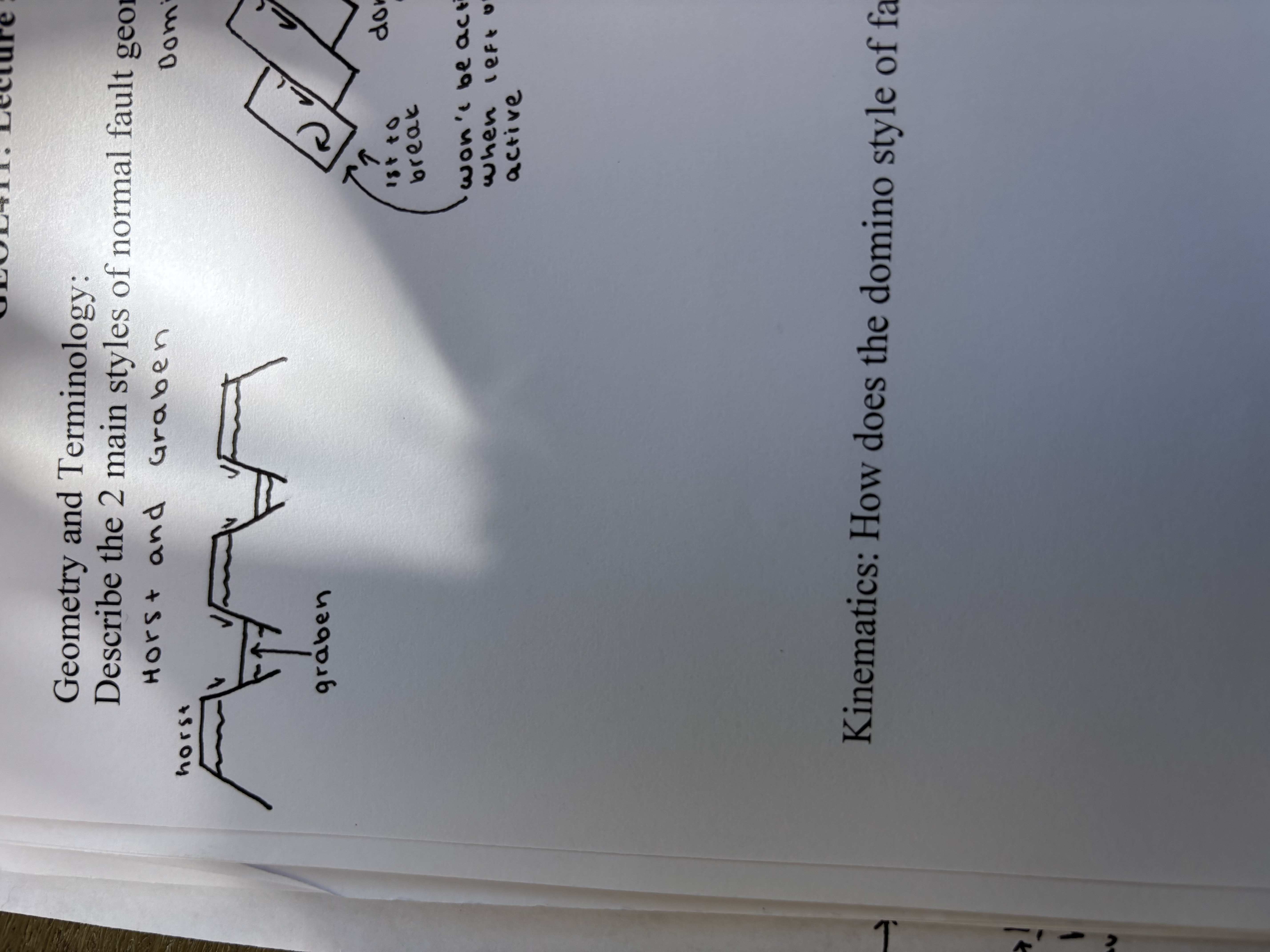
Passive Folding
Class 2 folds, limbs thinner than hinge, same interlimb angle of inner and outer arcs
Active folding
Layers are active in the folding process, class 1b folds, Baraboo
Critical wedge theory
Antiformal stack
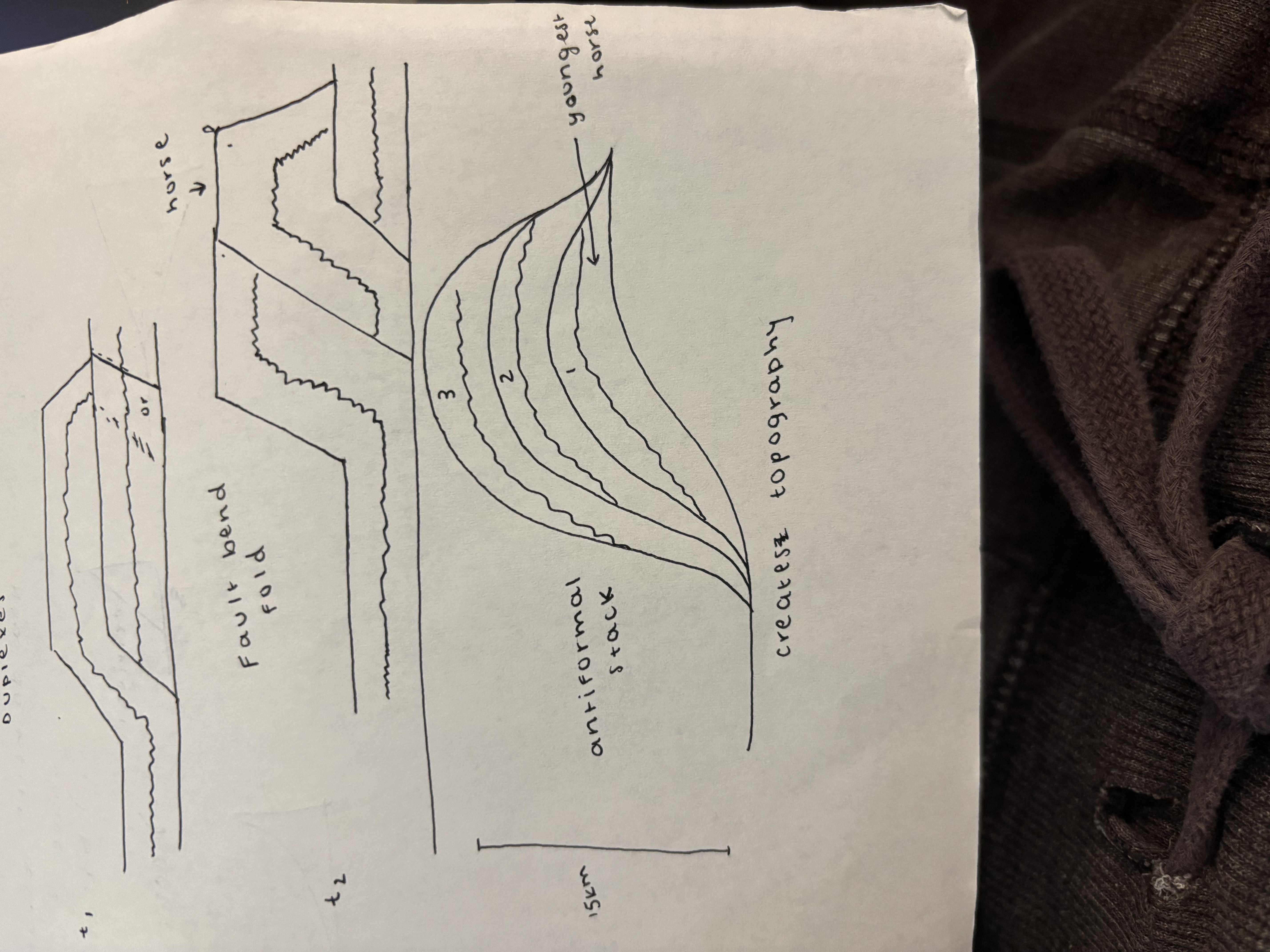
Buckle Folds
Active folding due to end unloading, high grade metamorphic rocks (more plasticky). Requires layer parallel shortening and a strong viscosity contrast between layers and matrix. Mechanical instability.
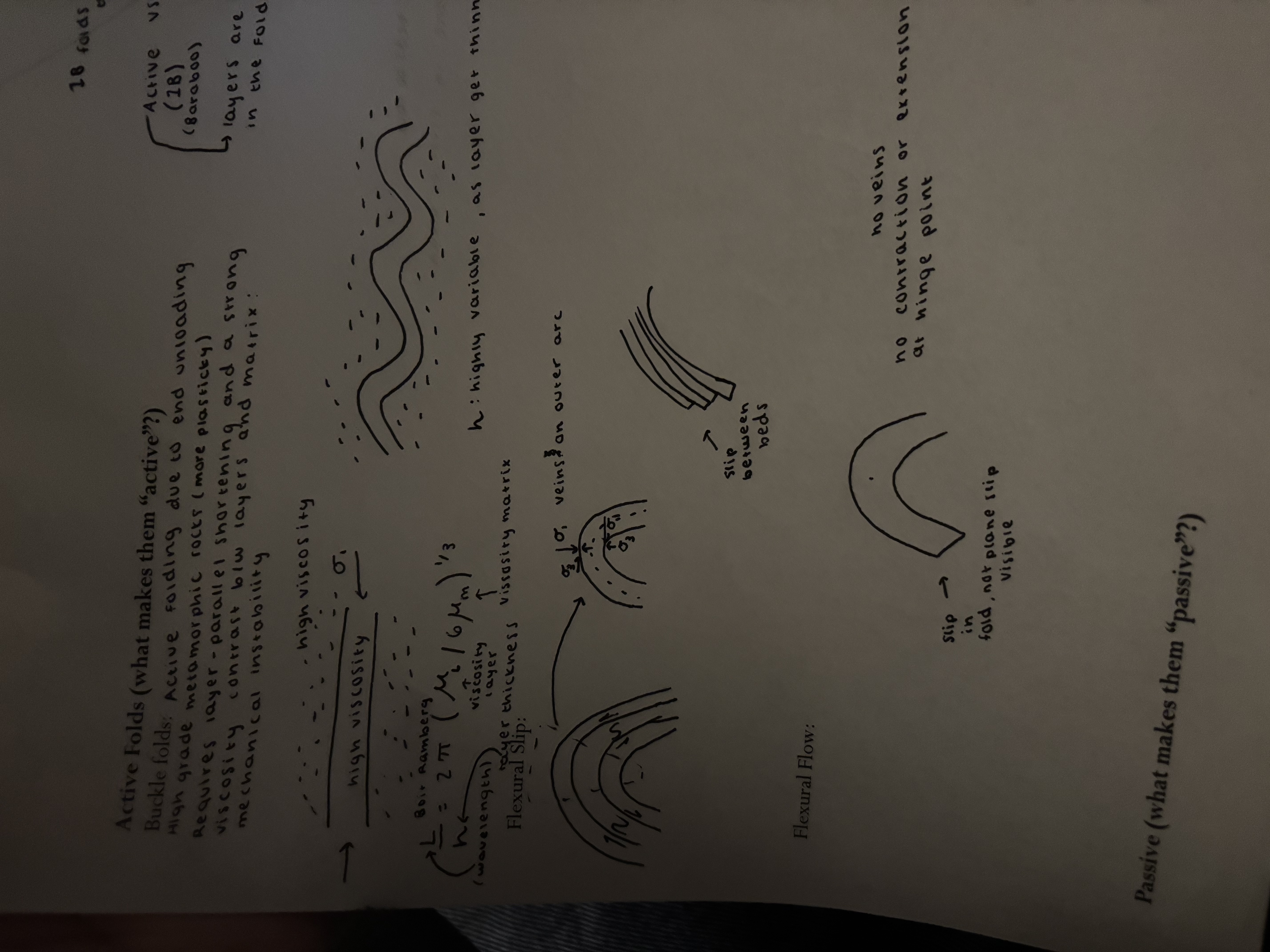
Rift Setting of Normal Fault
a. symmetric rift setting: Broad extension to accommodate thinning, b/c symmetric we encounter Horst and Graben style normal faults primarily
b. Asymmetric rift settings: mostly domino style normal faulting
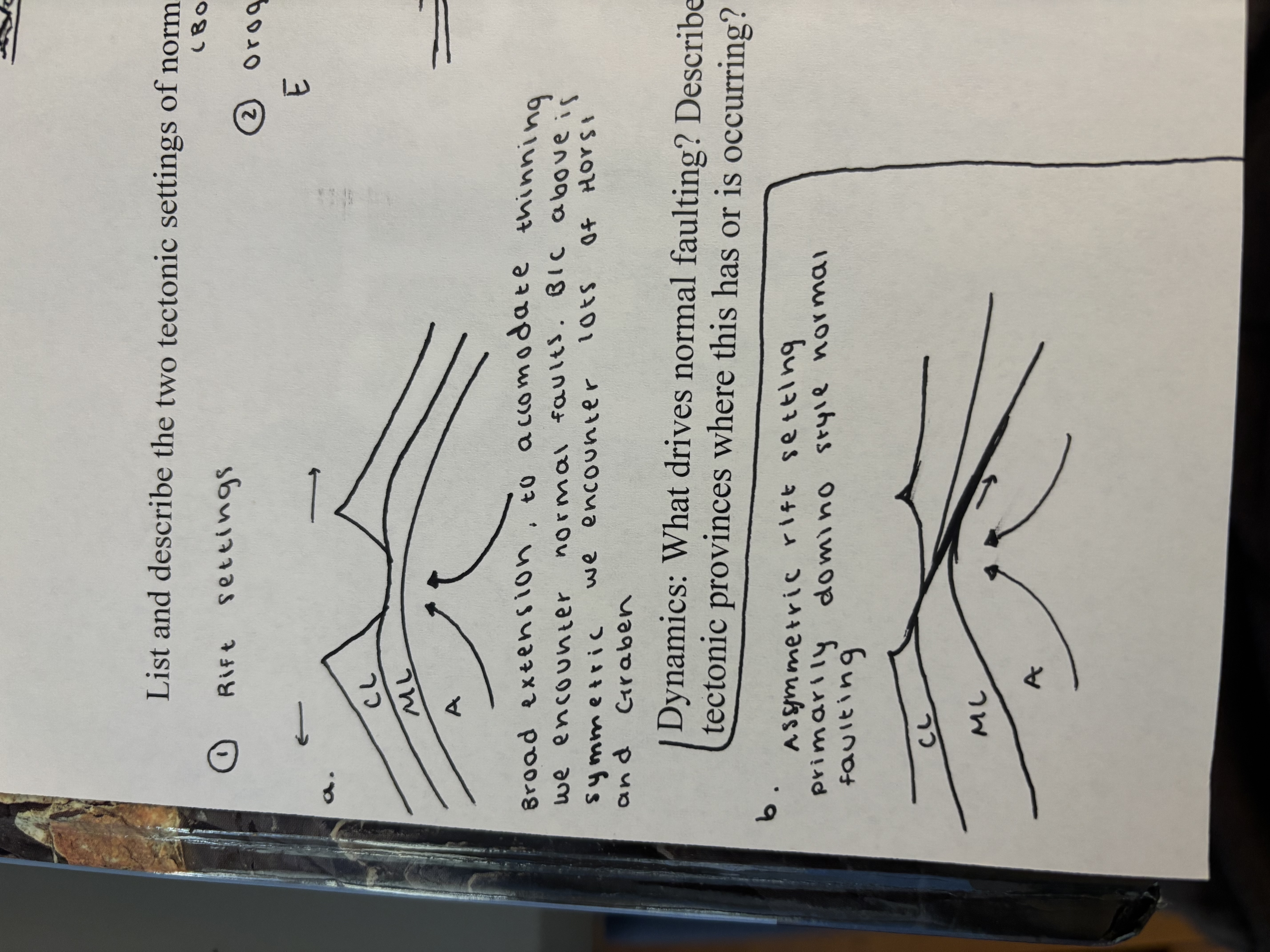
Orogenic Belt setting of normal faults
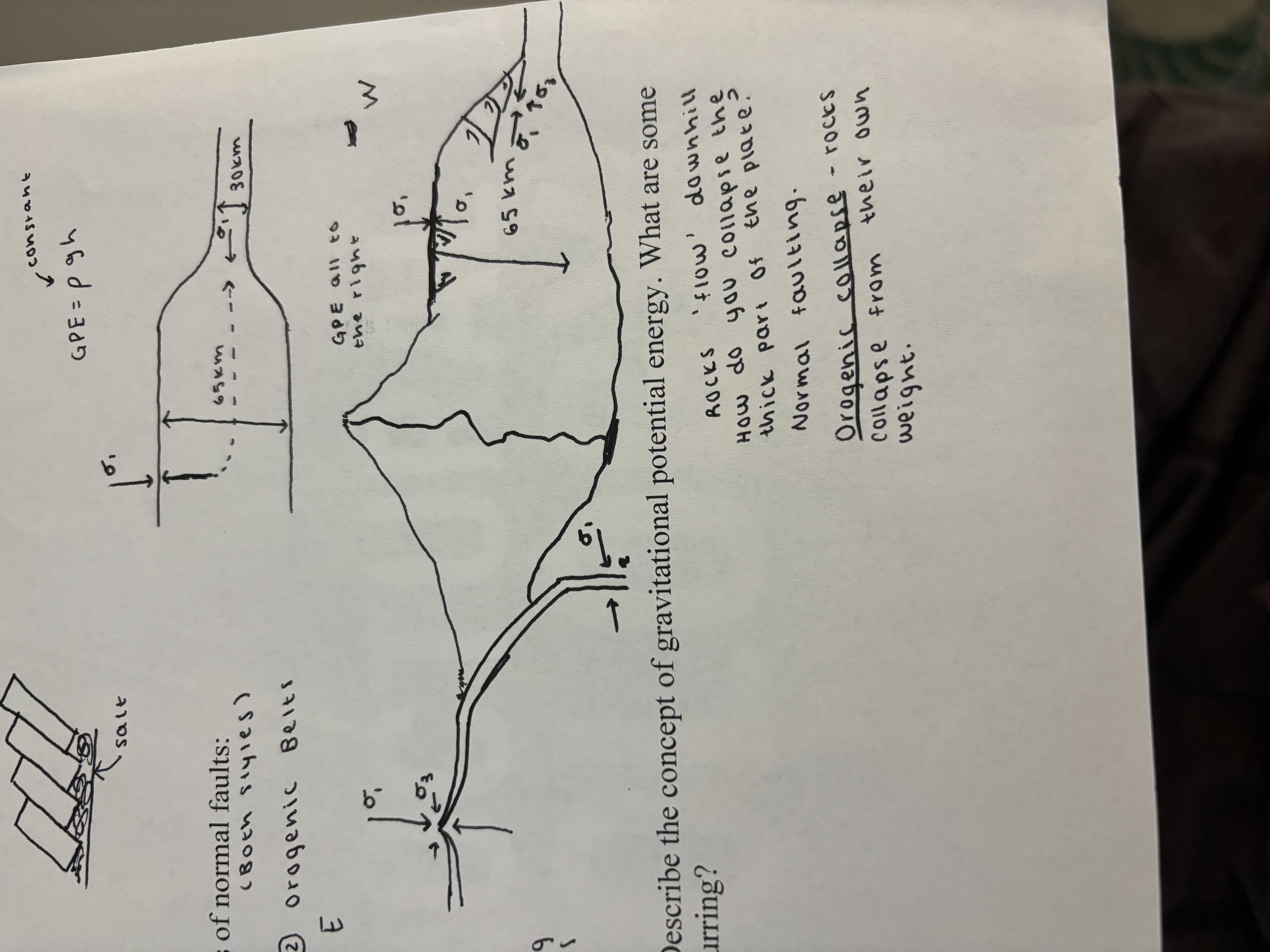
Orogenic Collapse
Rocks collapse from their own weight due to gravitational potential energy. Rocks ‘flow’ downhill How do you collapse the thick portion of the plate? Normal faulting.
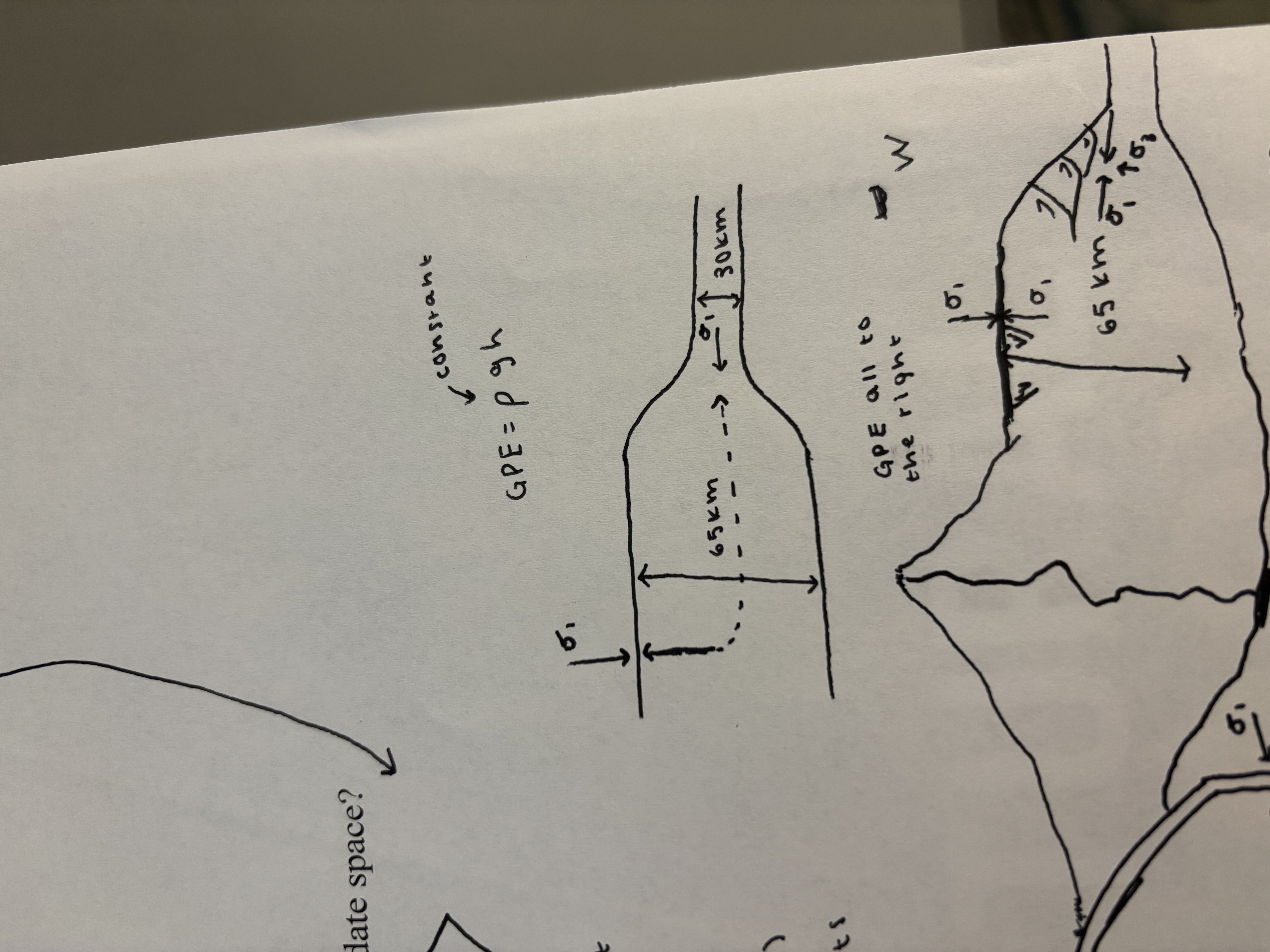
Gravitational Potential Energy
density * gravitational constant * height
Stress on Normal Faults
Anderson’s theory of faulting
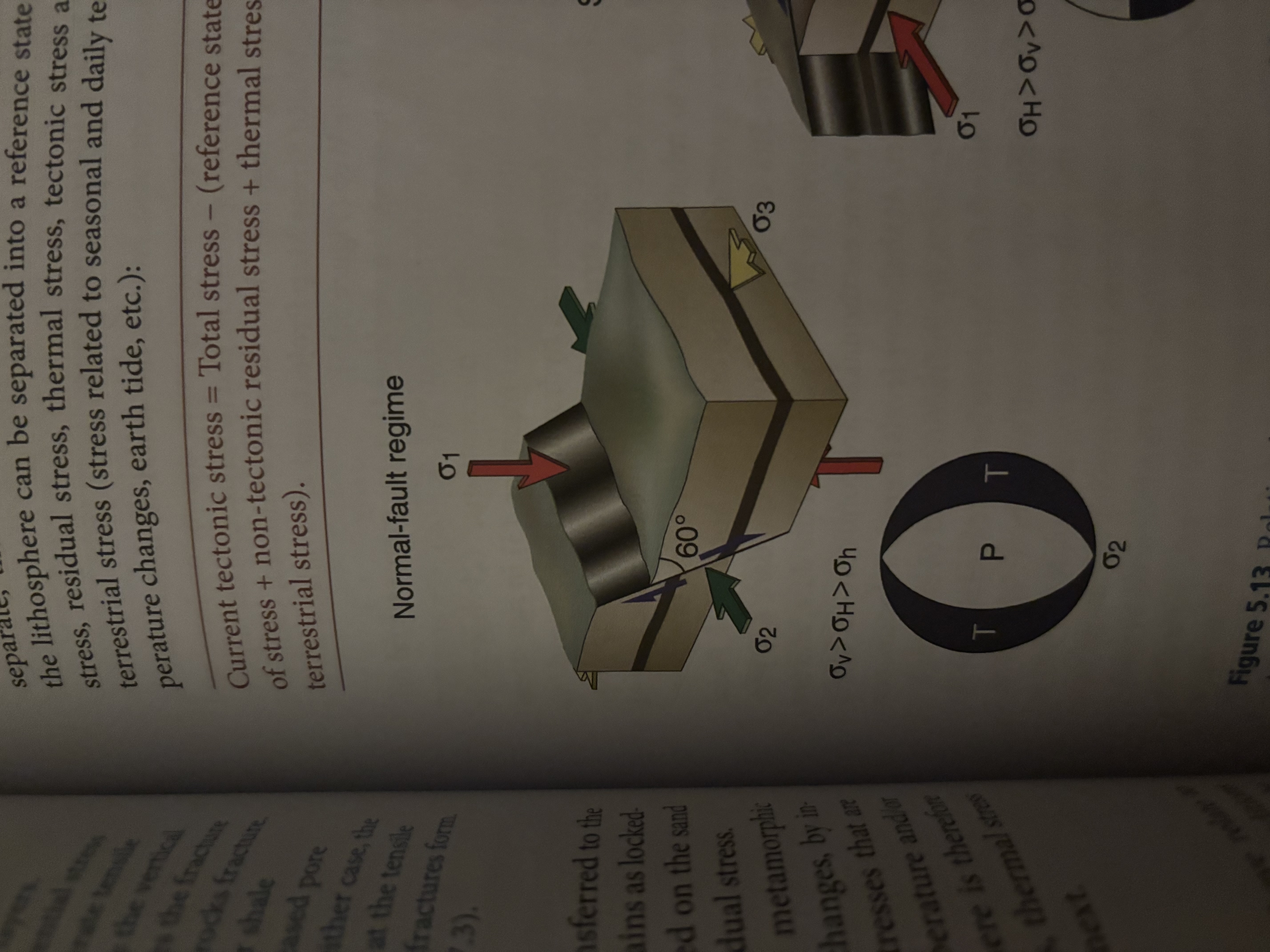
Stress on Reverse Faults
Anderson’s theory of faulting
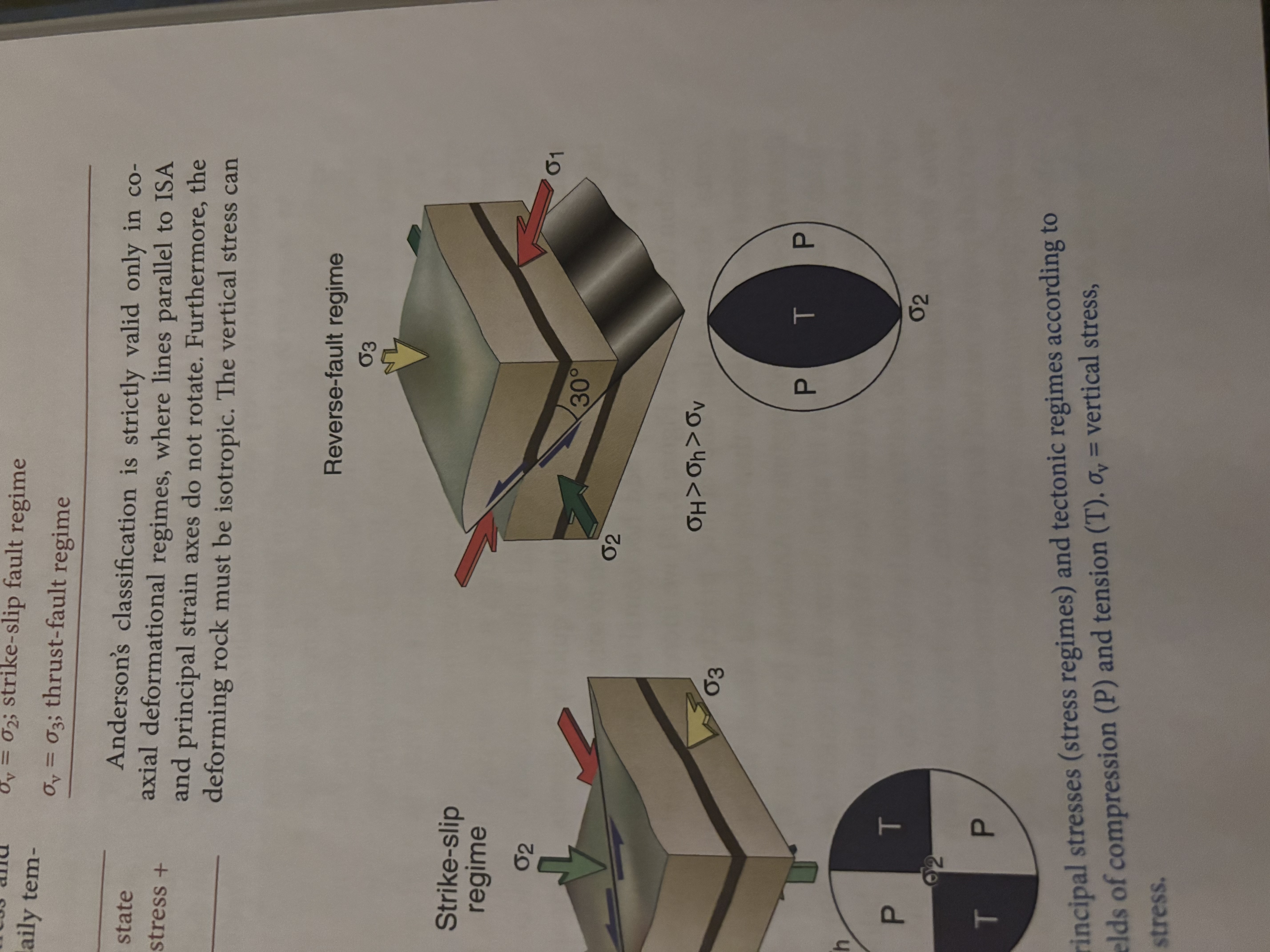
Heave and Throw
Heave - horizontal component of slip, Throw - vertical component of slip